Developing AI/ML Based Predictive Capabilities for a Compression Ignition Engine Using Pseudo Dynamometer Data
Abstract
1. Introduction
1.1. Artificial Intelligence and Machine Learning
1.2. Applied Artificial Intelligence and Machine Learning: Powertrain
1.3. Applied Artificial Intelligence and Machine Learning: Engine
2. Modeling
2.1. Compression Ignition Engine Configuration
2.2. Compression Ignition Engine Maps
3. Algorithm Development and Experimentation
3.1. Input Feature Selection
3.2. Target Feature Selection
3.3. Feature Normalization
3.4. Algorithm Selection
3.5. Algorithm Experimentation
4. Results
4.1. Single-Point Operational Conditions
4.2. Multi-Point Operational Conditions
5. Conclusions and Future Work
Author Contributions
Funding
Acknowledgments
Conflicts of Interest
Abbreviations
| Definitions | |
| Crank Angle | |
| Vector of Crank Angle Values | |
| Fuel Index/Throttle | |
| Engine Speed | |
| Vector of Engine Speed Values | |
| Bore Length | |
| Stroke Length | |
| Connecting Rod Length | |
| Crank Radius Length | |
| Piston Position as a Function of Crank Angle | |
| Clearance Volume | |
| Piston Volume as a Function of Crank Angle | |
| Maximum Displacement | |
| Total Number of Cylinders | |
| Compression Ratio | |
| Angular Velocity of Engine | |
| Angular Acceleration of Engine | |
| Engine Inertia | |
| Engine Damping | |
| Brake Torque | |
| Load Torque | |
| In-cylinder Pressure | |
| Proceeding Crank Angle at time t | |
| Proceeding Crank Angle at time t | |
| ⋮ | ⋮ |
| Proceeding Crank Angle at time t | |
| Proceeding Crank Angle at time t | |
| ⋮ | ⋮ |
| After Crank Angle at time t | |
| ⋮ | ⋮ |
| After Crank Angle at time t | |
| Atmospheric Temperature | |
| Atmospheric Pressure | |
| Piston Surface Area as a Function of Crank Angle | |
| Per-Cylinder Rated Engine Power | |
| Rated Engine Power | |
| Rated Engine Speed | |
| Total Displayed Volume | |
| Lookup Table Interpolated Engine State for Cylinder 1 | |
| ANN Predicted Engine State for Cylinder 1 | |
| CNN Predicted Engine State for Cylinder 1 | |
| KNN Predicted Engine State for Cylinder 1 | |
| Acronyms | |
| AFRL | Air Forces Research Laboratory |
| AI | Artificial Intelligence |
| ARL | Army Research Laboratory |
| BDC | Bottom Dead Center |
| CNN | Convolutional Neural Network |
| CAD | Crank Angle Degree |
| CCDC | Combat Capabilities Development Command |
| CI | Compression Ignition |
| DP | Dynamic Programming |
| EMS | Energy Management Strategy |
| GVSC | Ground Vehicle System Center |
| HEMTT | Heavy Expanded Mobility Tactical Truck |
| ICE | Internal Combustion Engine |
| KNN | Kth Nearest Neighbor |
| LSTMN | Long-Short Term Memory Network |
| ML | Machine Learning |
| ResNet | Residual Neural Network |
| RNN | Recurrent Neural Network |
| RPM | Revolution per Minute |
| SANN | Shallow Artificial Neural Network |
| SMET | Squad Multipurpose Equipment Transport |
| TDC | Top Dead Center |
| UAV | Unmanned Ariel Vehicle |
| UGV | Unmanned Ground Vehicle |
| USV | Unmanned Surface Vehicle |
Appendix A
| Sensor | Description | Signal Name | Units | Variable Name | Size |
|---|---|---|---|---|---|
| N/A | N/A | Crank Angle Degrees | deg | CAD | |
| P1 | Inlet Conditions | Pressure | kPa | P1_pres | |
| Temperature | K | P1_temp | |||
| Gamma | P1_gamma | ||||
| Mass Fraction Unburned Air | g/g | P1_ubAir | |||
| Mass Fraction Unburned Vapor Fuel | g/g | P1_ubVapFuel | |||
| Mass Fraction Unburned Liquid Fuel | g/g | P1_ubLiqFuel | |||
| Mass Fraction Unburned Other | g/g | P1_ubOther | |||
| Mass Fraction Burned Gas | g/g | P1_bGas | |||
| Enthalpy | kJ/kg | P1_enth | |||
| Mass Flow Rate | kg/s | P1_mdot | |||
| P2 | Inlet Conditions of Air Chiller | Pressure | P2_pres | ||
| Temperature | K | P2_temp | |||
| Gamma | P2_gamma | ||||
| Mass Fraction Unburned Air | g/g | P2_ubAir | |||
| Mass Fraction Unburned Vapor Fuel | g/g | P2_ubVapFuel | |||
| Mass Fraction Unburned Liquid Fuel | g/g | P2_ubLiqFuel | |||
| Mass Fraction Unburned Other | g/g | P2_ubOther | |||
| Mass Fraction Burned Gas | g/g | P2_bGas | |||
| Enthalpy | kJ/kg | P2_enth | |||
| Mass Flow Rate | kg/s | P2_mdot | |||
| P3 | Intake Manifold | Pressure | kPa | P3_pres | |
| Temperature | K | P3_temp | |||
| Gamma | P3_gamma | ||||
| Mass Fraction Unburned Air | g/g | P3_ubAir | |||
| Mass Fraction Unburned Vapor Fuel | g/g | P3_ubVapFuel | |||
| Mass Fraction Unburned Liquid Fuel | g/g | P3_ubLiqFuel | |||
| Mass Fraction Unburned Other | g/g | P3_ubOther | |||
| Mass Fraction Burned Gas | g/g | P3_bGas | |||
| Enthalpy | kJ/kg | P3_enth | |||
| Mass Flow Rate | kg/s | P3_mdot | |||
| P4 | In-cylinder Conditions | Pressure | P4_cyl#_pres | ||
| Temperature | K | P4_cyl#_temp | |||
| Gamma | P4_cyl#_gamma | ||||
| Mass Flow Fuel | kg/s | P4_cyl#_mdotFuel | |||
| Mass Fraction Unburned Non Fuel | g/g | P4_cyl#_ubNonFuel | |||
| Mass Fraction Fuel | g/g | P4_cyl#_fuel | |||
| Mass Fraction Burned Fuel | g/g | P4_cyl#_burned | |||
| Mass Flow Rate | kg/s | P4_cyl#_mdotAir |
| Sensor | Description | Signal Name | Units | Variable Name | Size |
|---|---|---|---|---|---|
| P5 | Exhaust Manifold Conditions | Pressure | kPa | P5_pres | |
| Temperature | K | P5_temp | |||
| Gamma | P5_gamma | ||||
| Mass Fraction Unburned Air | g/g | P5_ubAir | |||
| Mass Fraction Unburned Vapor Fuel | g/g | P5_ubVapFuel | |||
| Mass Fraction Unburned Liquid Fuel | g/g | P5_ubLiqFuel | |||
| Mass Fraction Unburned Other | g/g | P5_ubOther | |||
| Mass Fraction Burned Gas | g/g | P5_bGas | |||
| Enthalpy | kJ/kg | P5_enth | |||
| Mass Flow Rate | kg/s | P5_mdot | |||
| P6 | Exhaust Outlet | Pressure | kPa | P6_pres | |
| Temperature | K | P6_temp | |||
| Gamma | P6_gamma | ||||
| Mass Fraction Unburned Air | g/g | P6_ubAir | |||
| Mass Fraction Unburned Vapor Fuel | g/g | P6_ubVapFuel | |||
| Mass Fraction Unburned Liquid Fuel | g/g | P6_ubLiqFuel | |||
| Mass Fraction Unburned Other | g/g | P6_ubOther | |||
| Mass Fraction Burned Gas | g/g | P6_bGas | |||
| Enthalpy | kJ/kg | P6_enth | |||
| Mass Flow Rate | kg/s | P6_mdot | |||
| P7 | Shaft Conditions | Output Brake Torque | Nm | P7_torqBrake | |
| Output Indicated Torque | Nm | P7_torqIndicated | |||
| Output Brake and Crank Torque | Nm | P7_torqBrakePlusCrank | |||
| Engine Speed | Nm | P7_rpm | |||
| P8 | Turbo Charger | Turbo Charger Shaft Torque | Nm | P8_torq | |
| Turbo Charger Shaft Speed | rpm | P8_rpm | |||
| P9 | Engine Block | Wall Temperature | K | wallTemp |
Appendix B

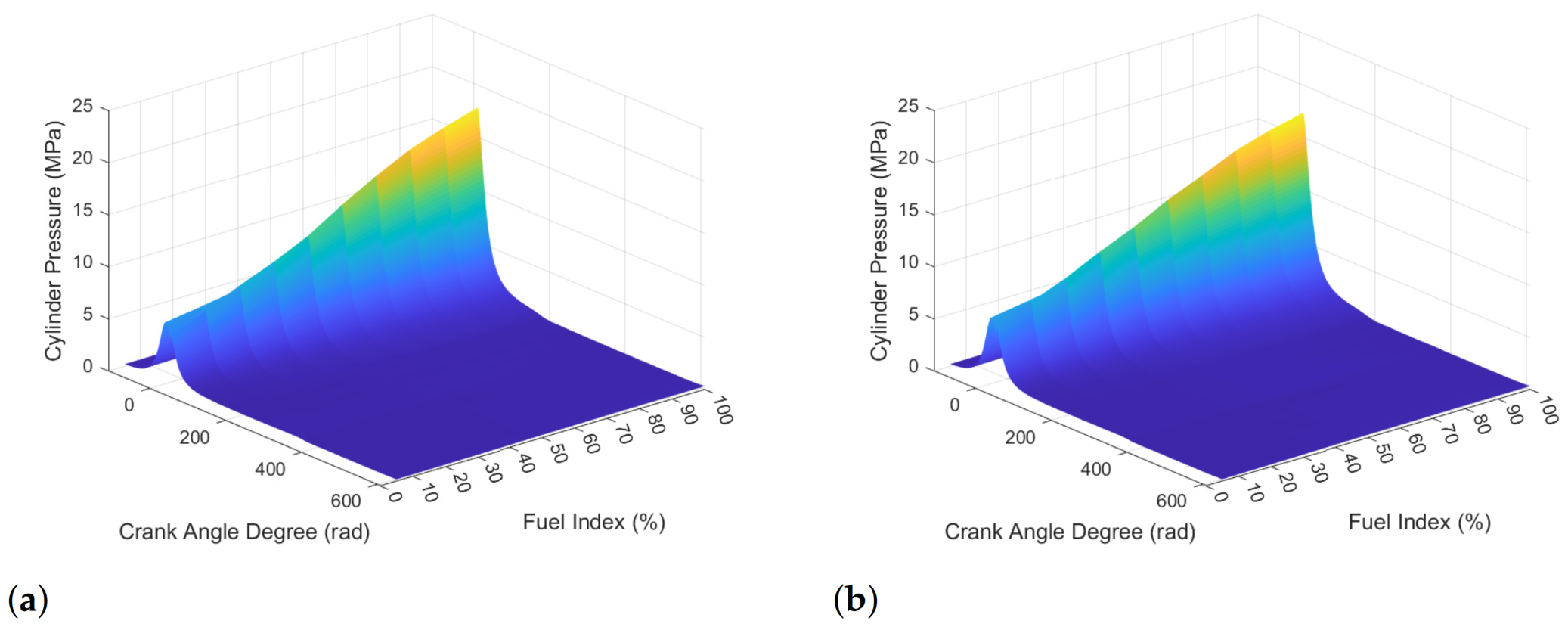
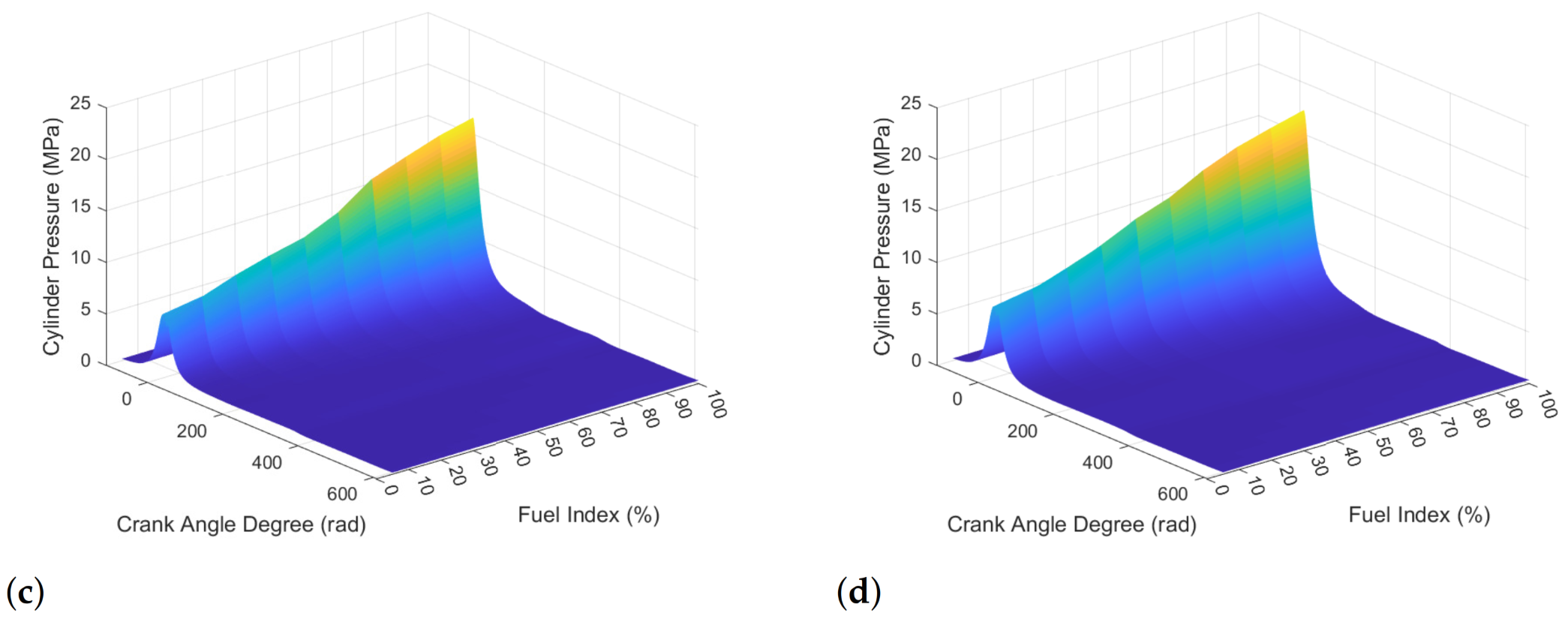
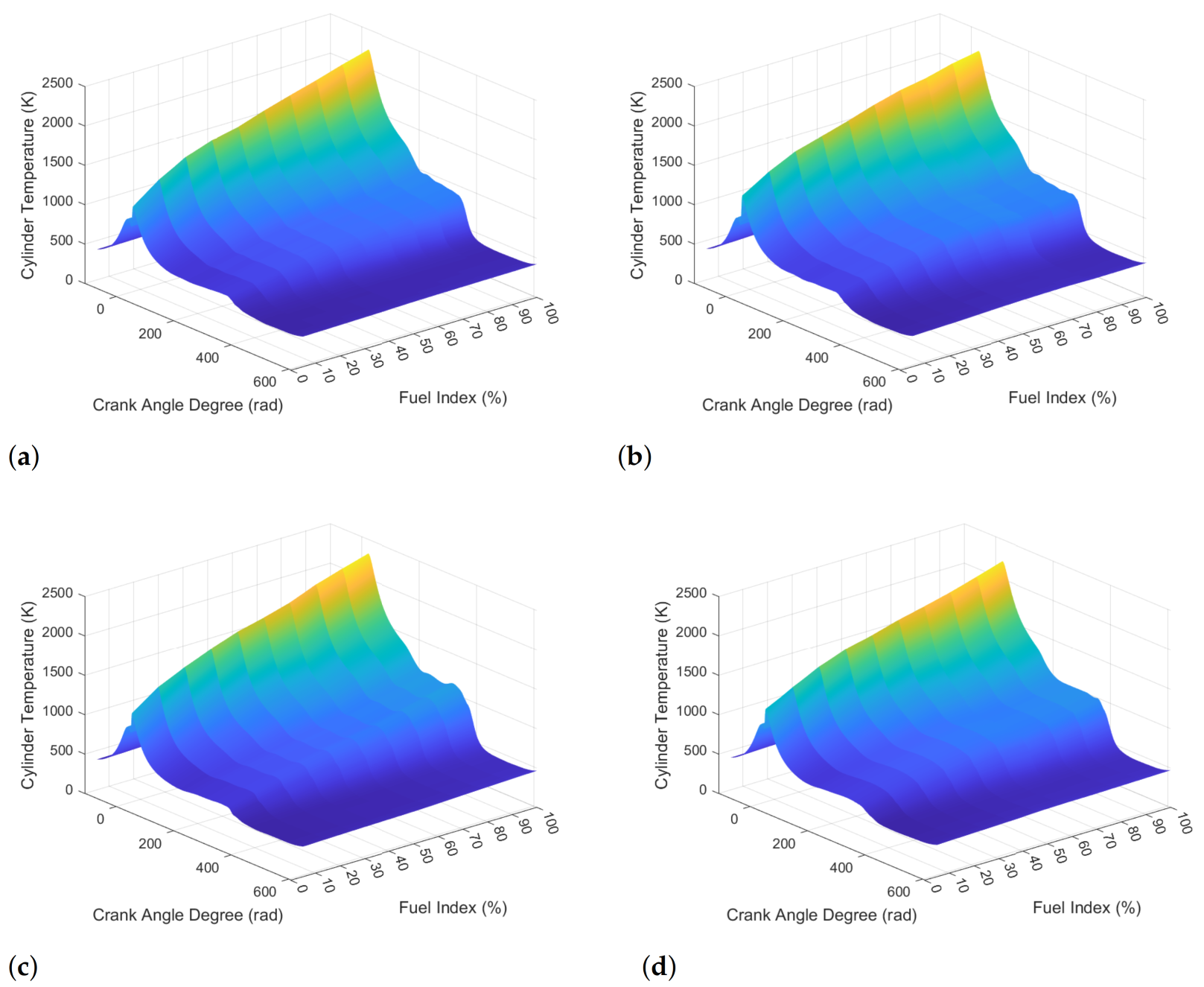
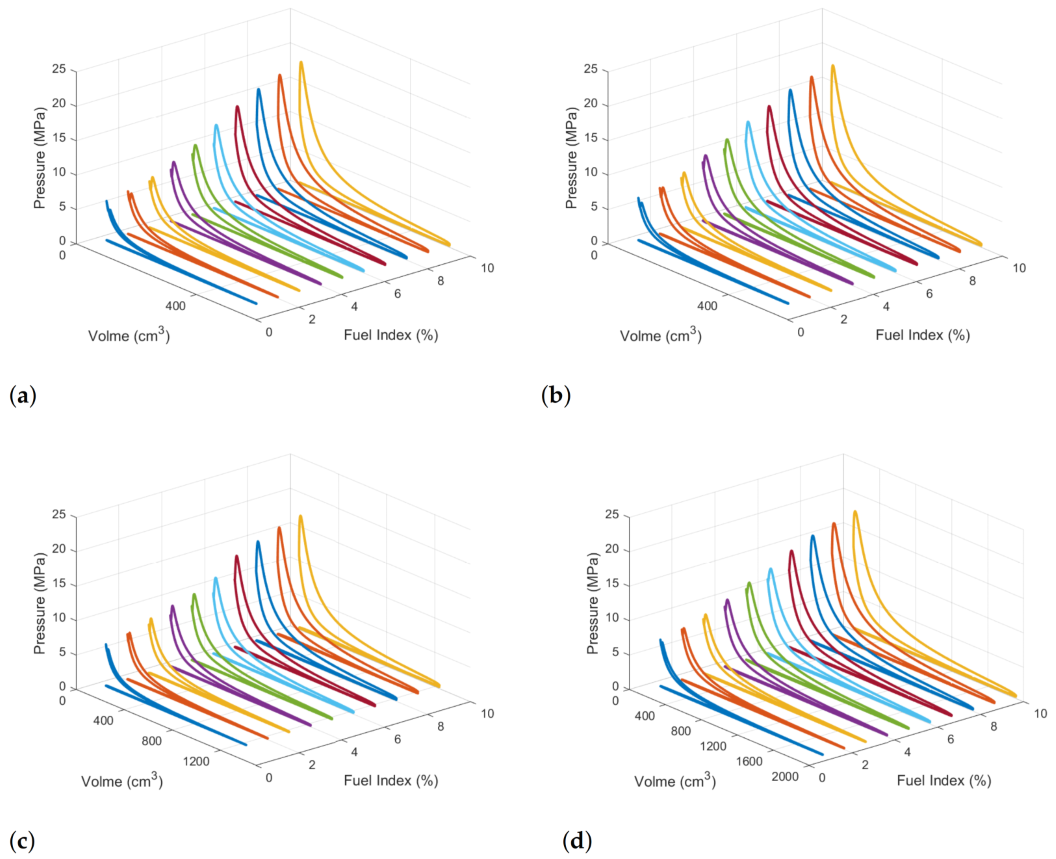
Appendix C
Appendix C.1. Artificial Neural Network


| Input Feature List | Recurrent Feature List | Target Feature List | Hidden Layer Size |
|---|---|---|---|
| , , , , | P4_cyl1_burned | ||
| P4_cyl1_fuel | |||
| P4_cyl1_gamma | |||
| P4_cyl1_mdotAir | |||
| P4_cyl1_mdotFuel | |||
| P4_cyl1_pres | |||
| P4_cyl1_temp | |||
| P4_cyl1_ubNonFuel |
Appendix C.2. Convolutional Neural Network

| Input Feature List | Recurrent Feature List | Target Feature List | Architecture |
|---|---|---|---|
| , , , , | P4_cyl1_burned | ↓ kernel_size = 5, strides = 2, activation = relu, padding = same) ↓ kernel_size = 5, strides = 2, activation = relu, padding = same) ↓ kernel_size = 5, strides = 2, activation = relu, padding = same) ↓ Global Averaging Pool ↓ Dense ↓ Linear Activation Layer ↓ | |
| P4_cyl1_fuel | |||
| P4_cyl1_gamma | |||
| P4_cyl1_mdotAir | |||
| P4_cyl1_mdotFuel | |||
| P4_cyl1_pres | |||
| P4_cyl1_temp | |||
| P4_cyl1_ubNonFuel |
Appendix C.3. Kth Nearest Neighbor Classifier
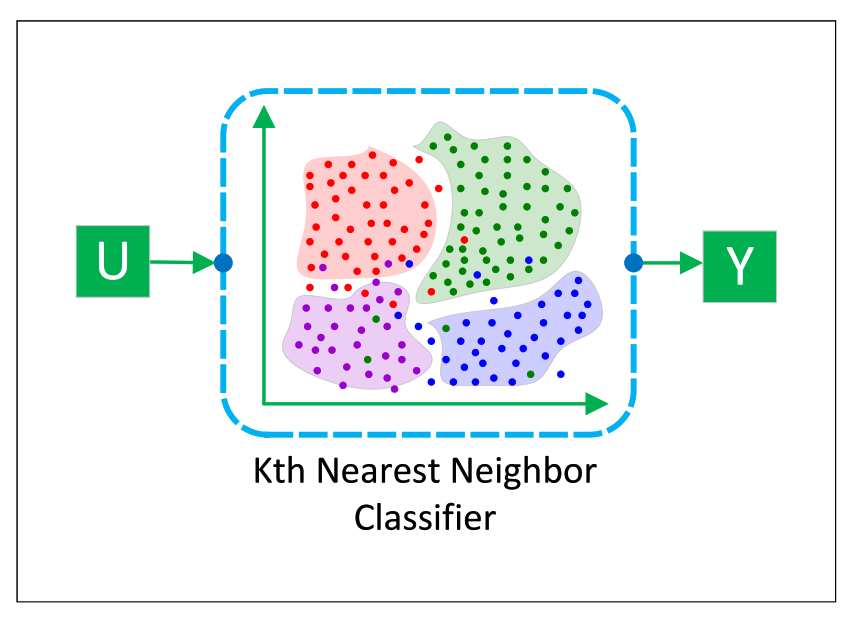
| Input Feature List | Recurrent Feature List | Target Feature List | Number of Nearest Neighbors |
|---|---|---|---|
| , , , N, | P4_cyl1_burned | 150 | |
| P4_cyl1_fuel | 75 | ||
| P4_cyl1_gamma | 5 | ||
| P4_cyl1_mdotAir | 25 | ||
| P4_cyl1_mdotFuel | 15 | ||
| P4_cyl1_pres | 150 | ||
| P4_cyl1_temp | 15 | ||
| P4_cyl1_ubNonFuel | 150 |
Appendix D
Appendix D.1. Additional Single-Point Operational Conditions Figures

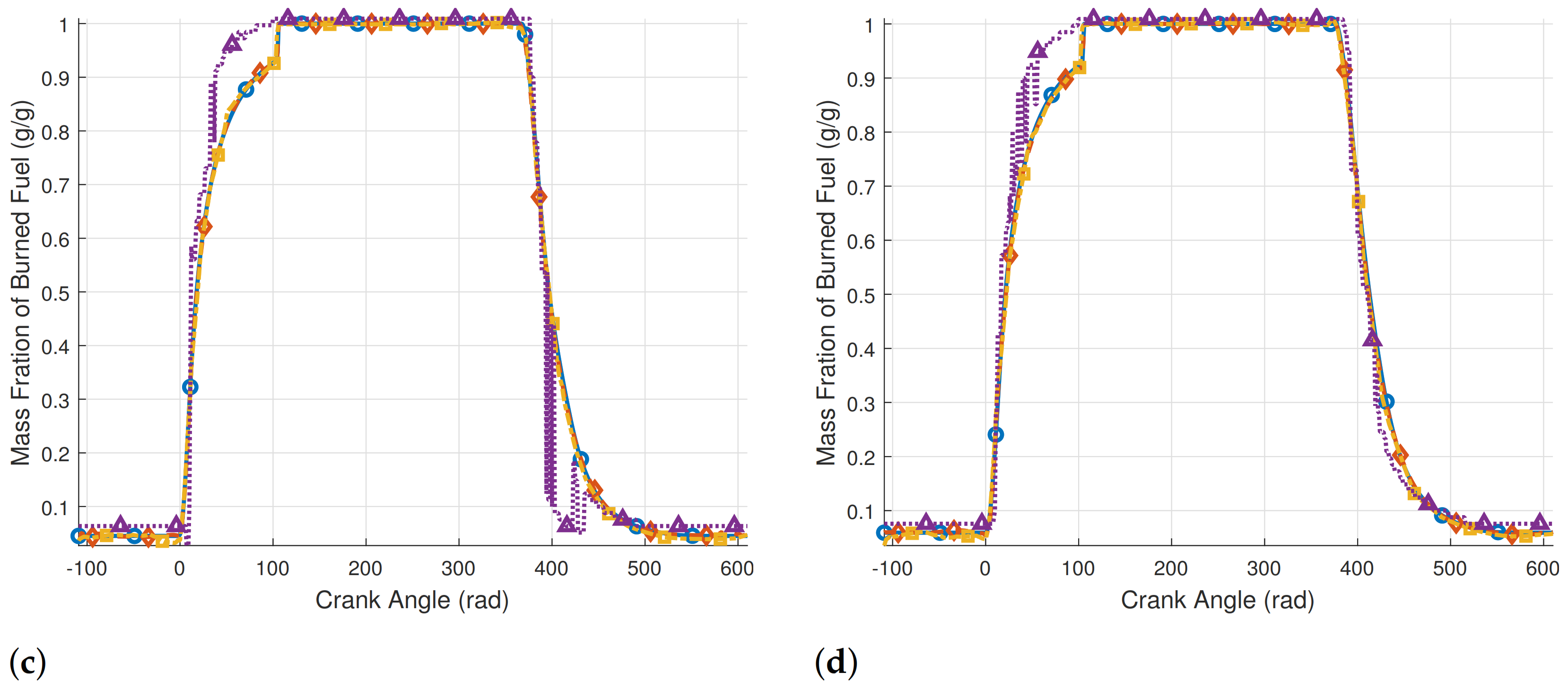
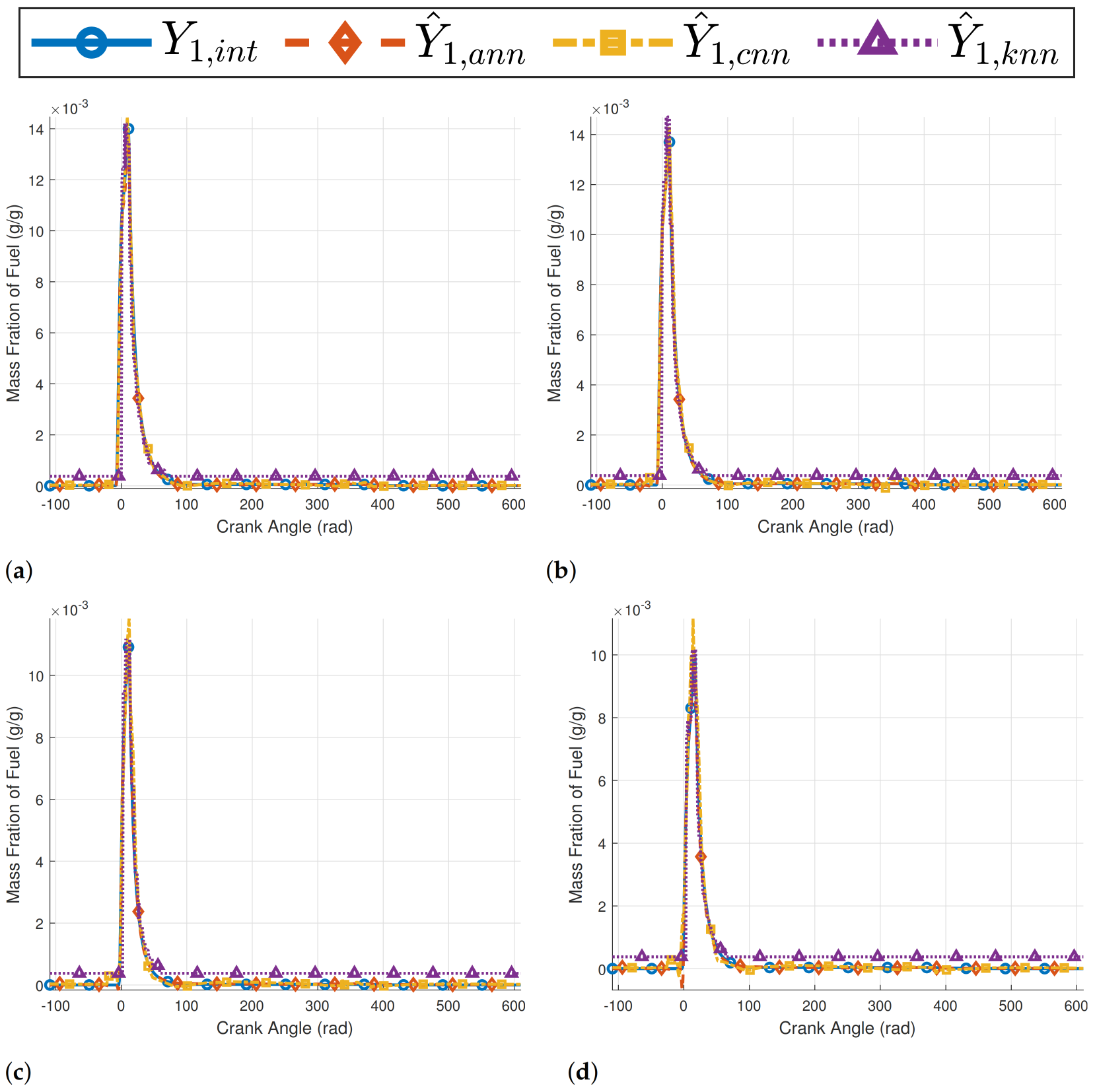
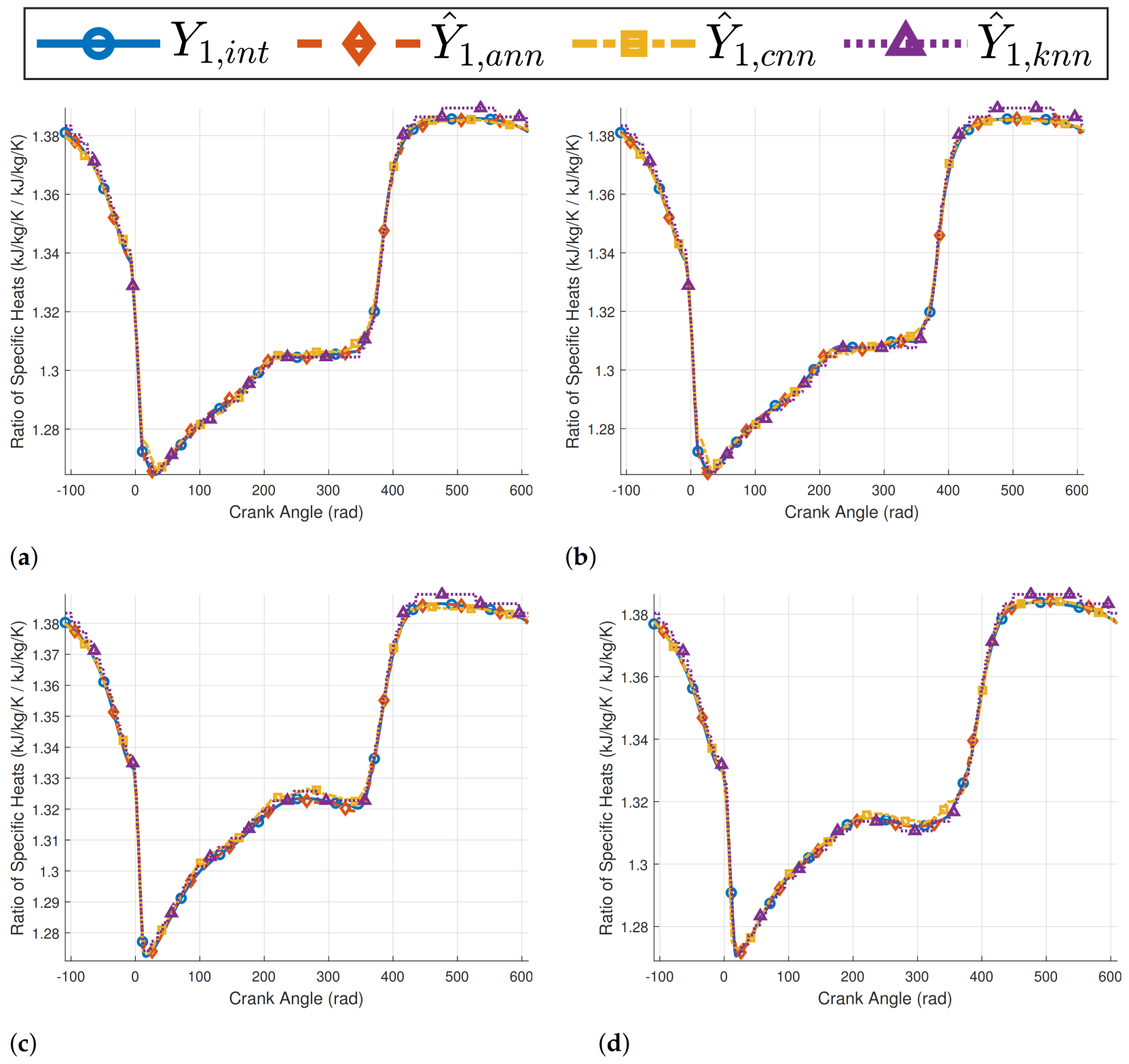

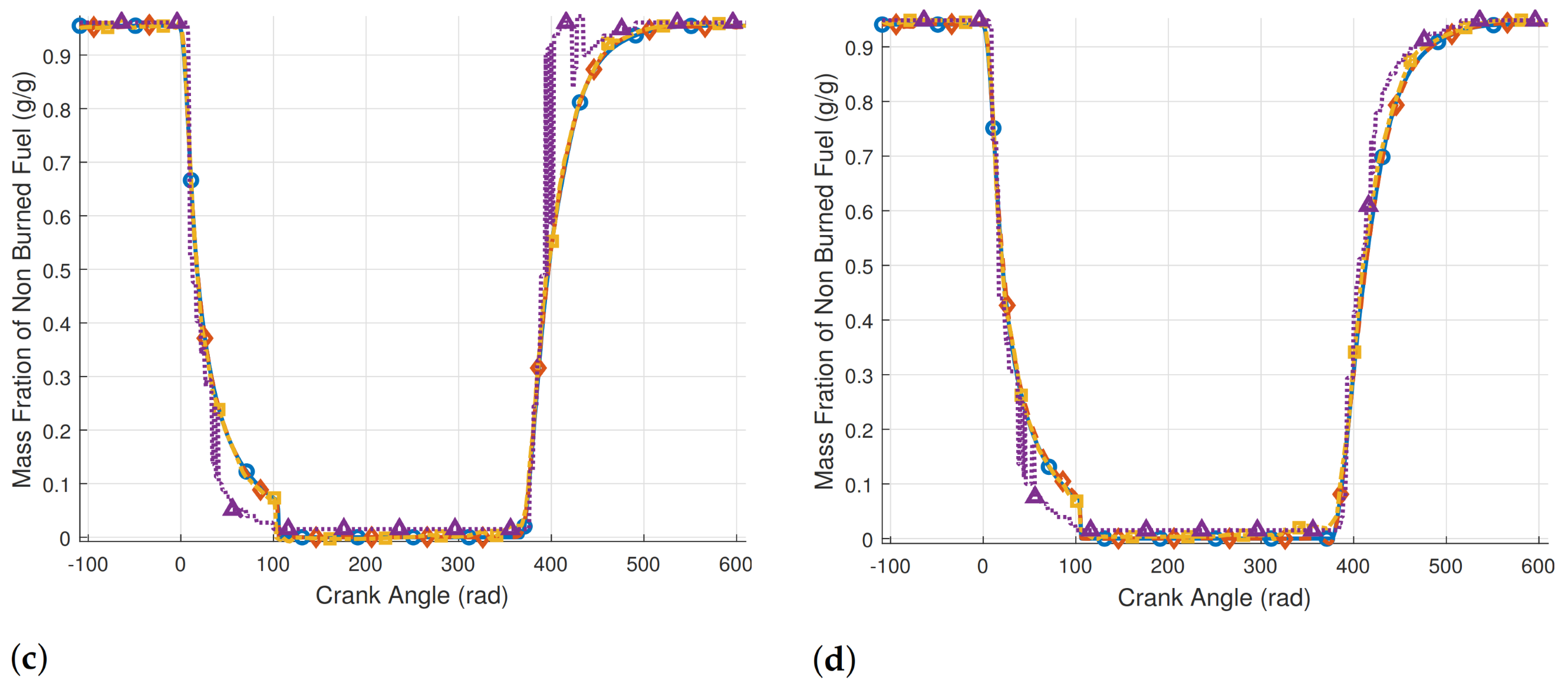
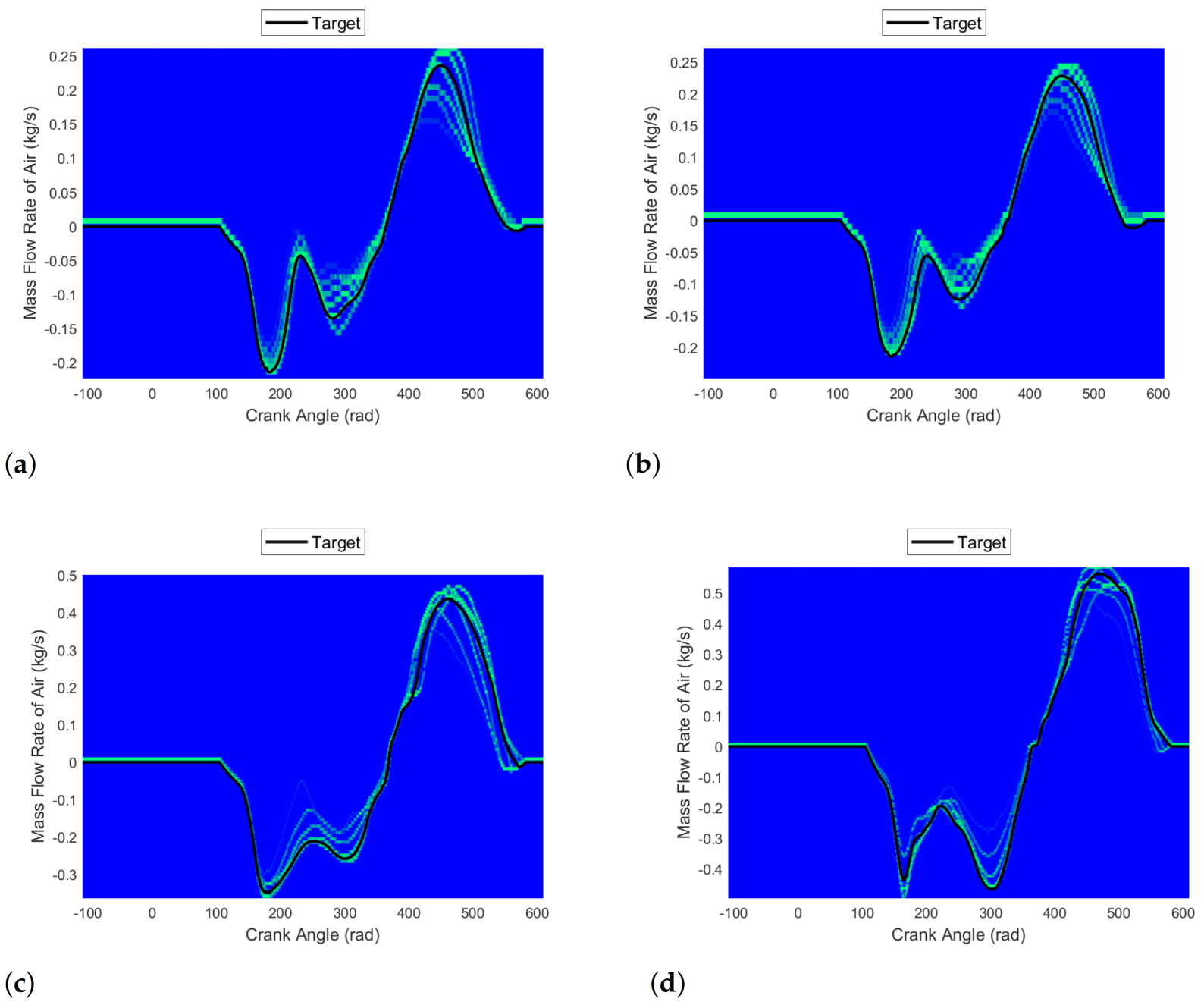

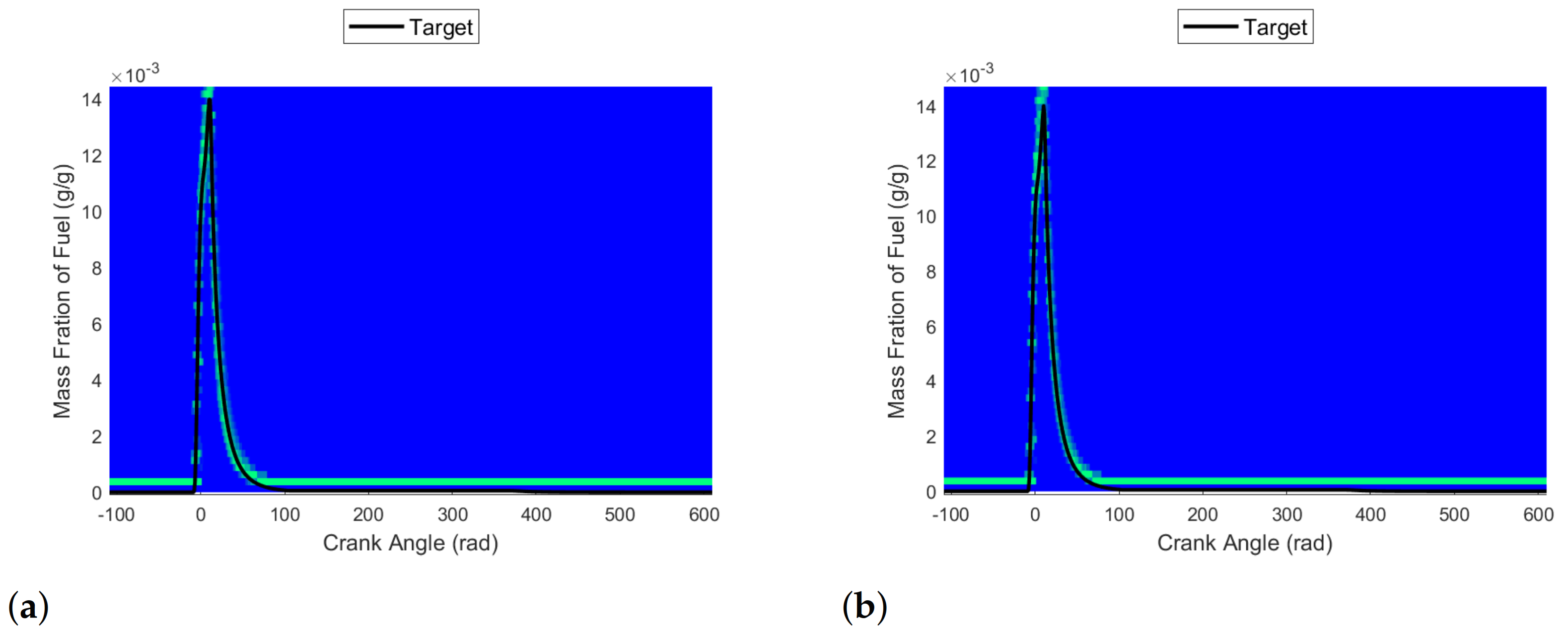
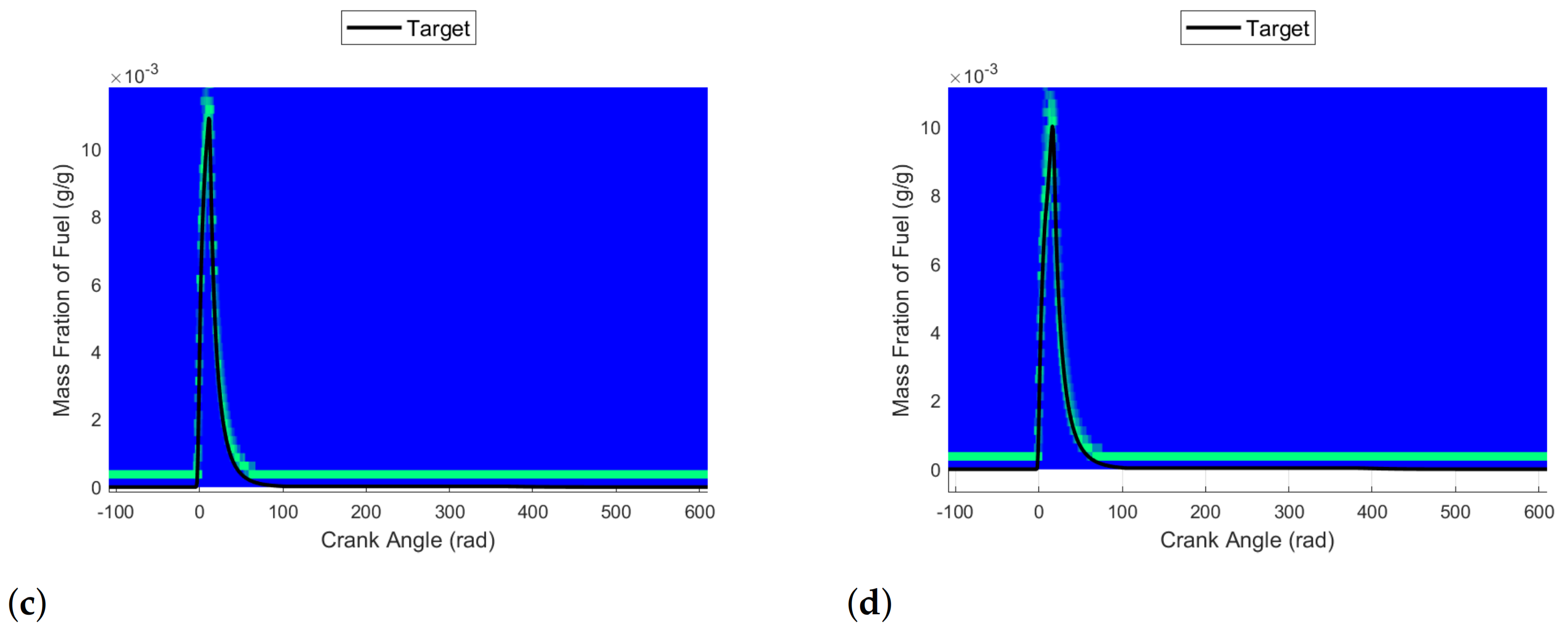

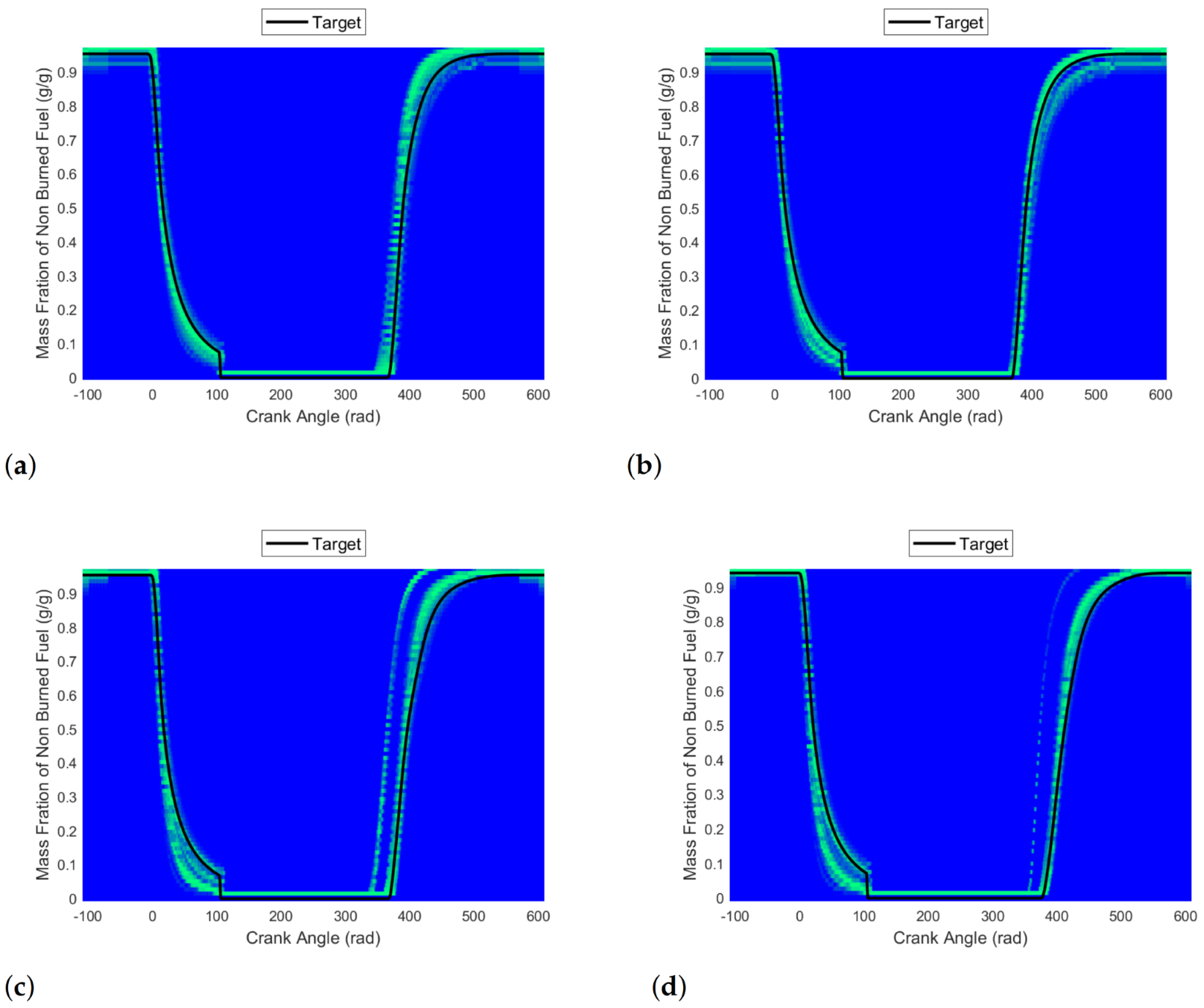
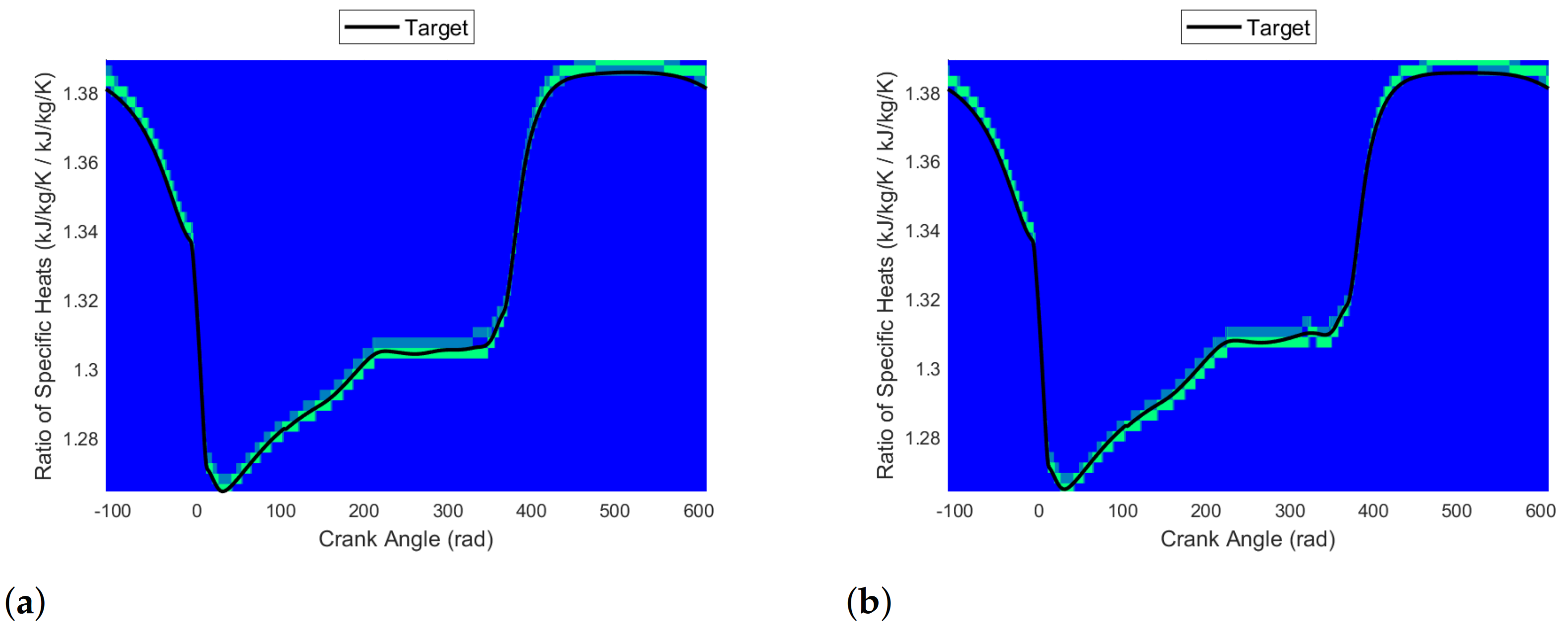
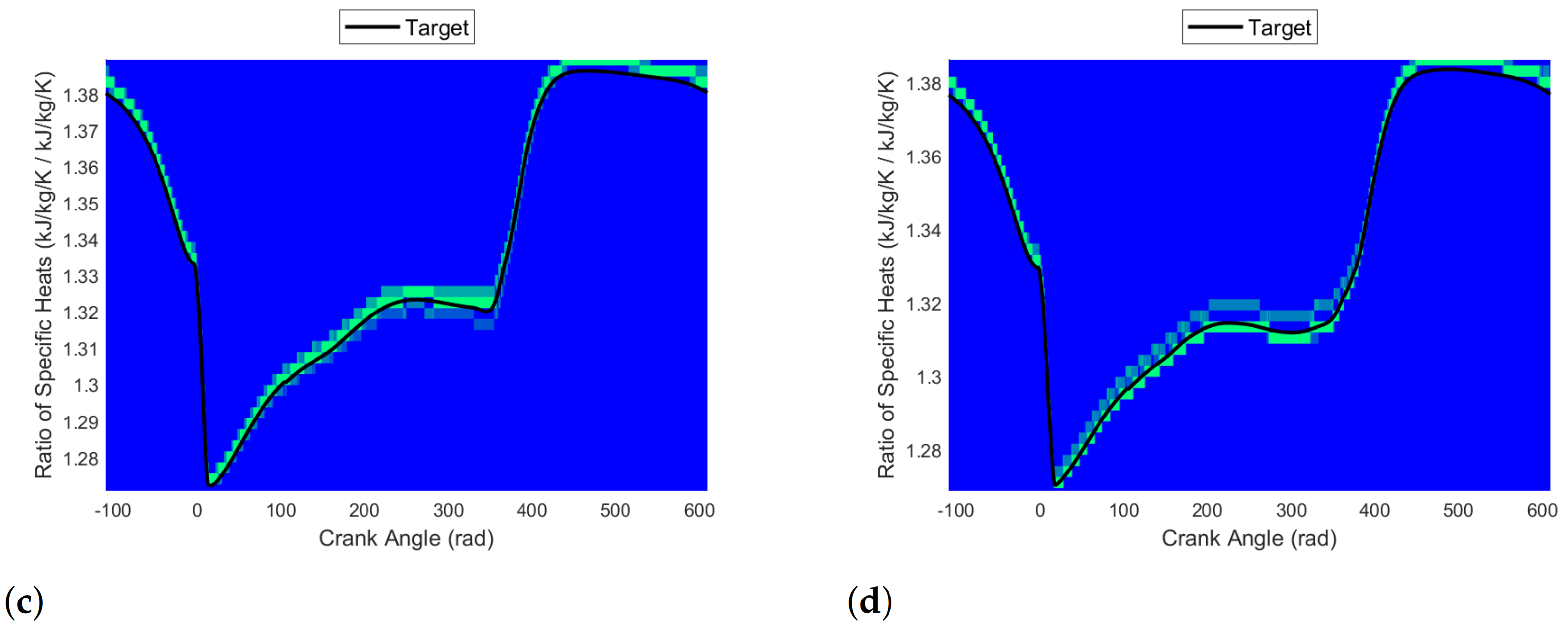
Appendix D.2. Additional Multi-Point Operational Conditions Figures

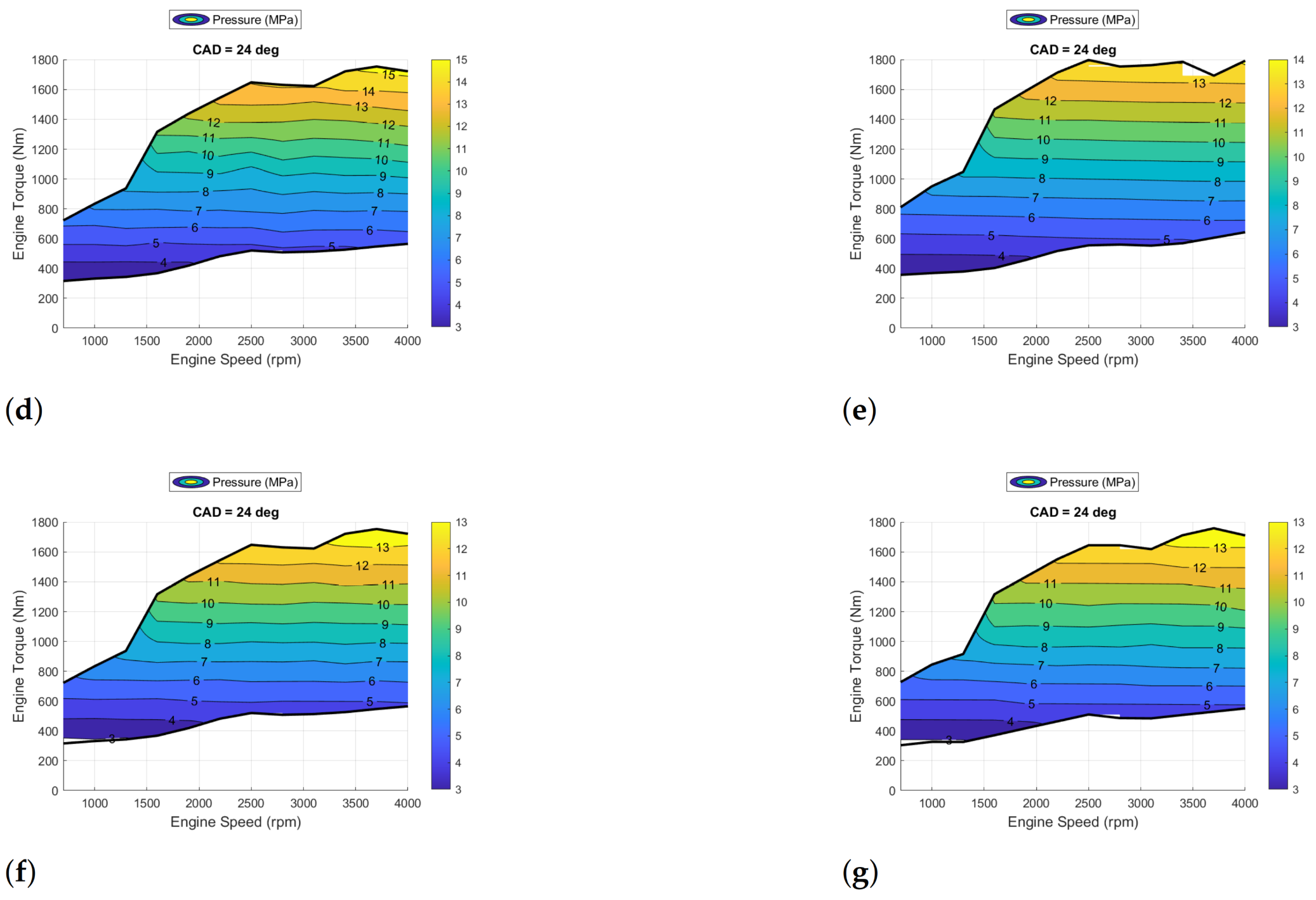
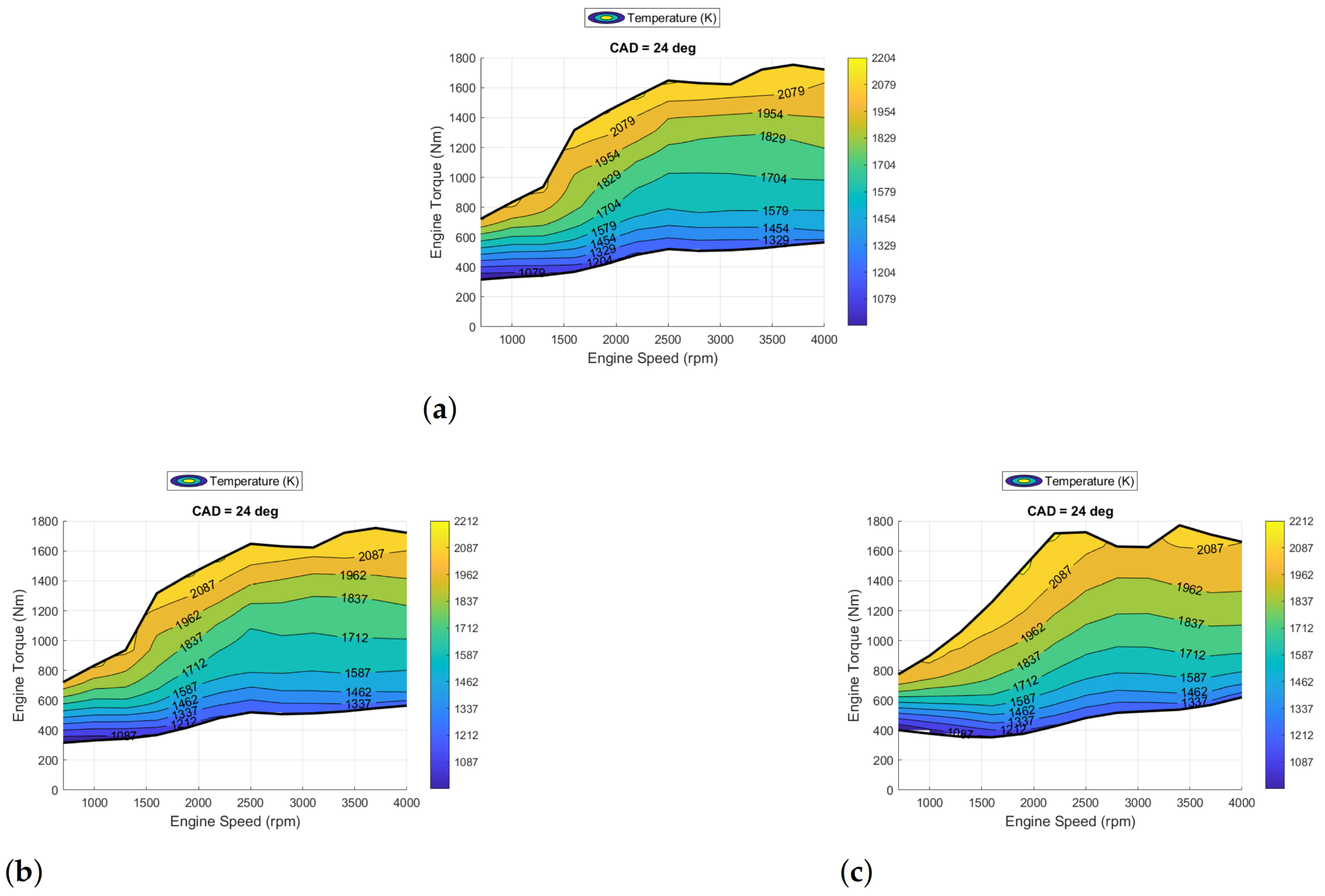




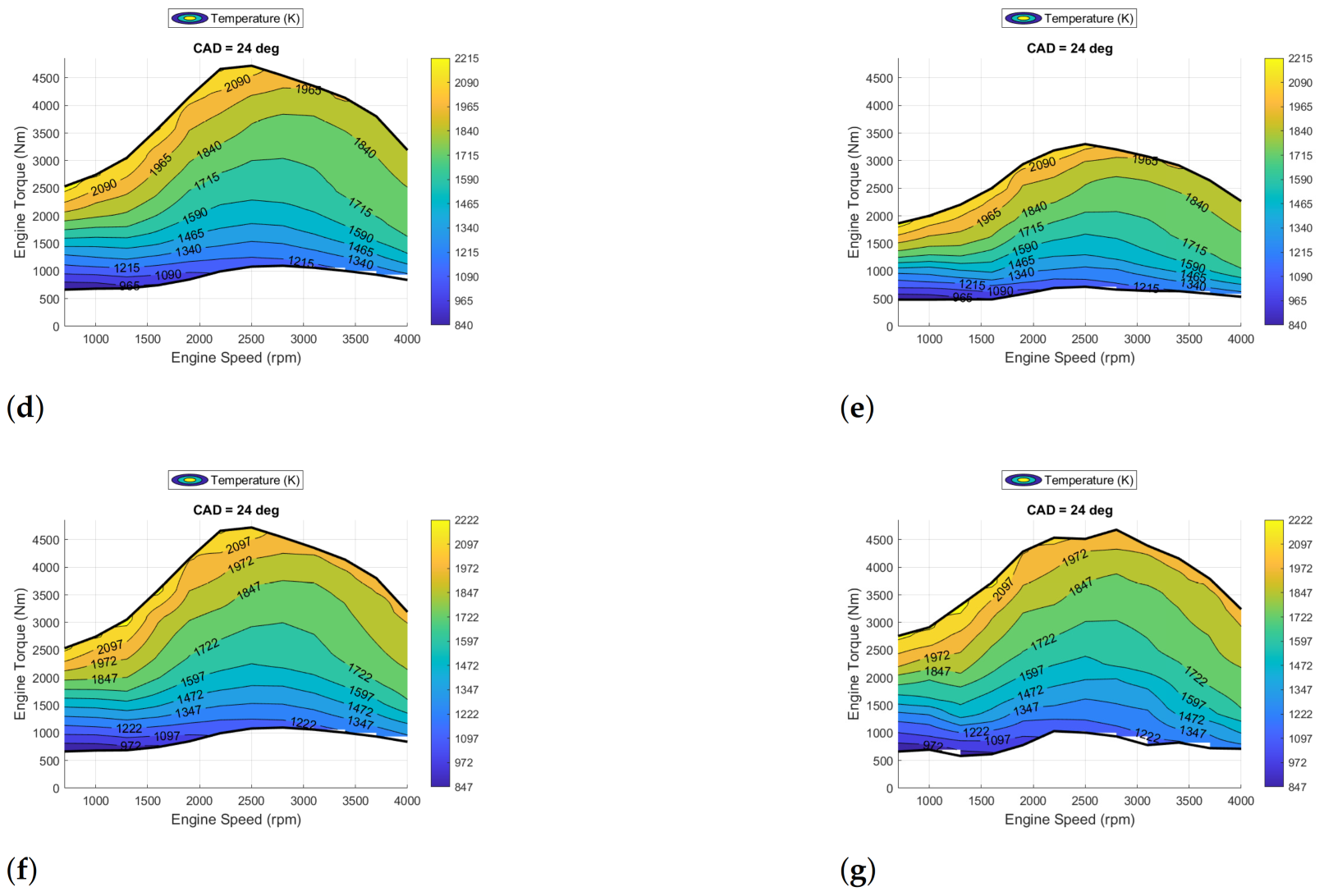
References
- Bourhis, G.; Leduc, P. Energy and exergy balances for modern diesel and gasoline engines. Oil Gas Sci. Technol.—Revue l’Institut Français du Pétrole 2010, 65, 39–46. [Google Scholar] [CrossRef]
- Reed, R.; Marks, R.J., II. Neural Smithing: Supervised Learning in Feedforward Artificial Neural Networks; MIT Press: Cambridge, MA, USA, 1999. [Google Scholar]
- Billings, S.A. Nonlinear System Identification: NARMAX Methods in the Time, Frequency, and Spatio-Temporal Domains; John Wiley & Sons: Hoboken, NJ, USA, 2013. [Google Scholar]
- Medsker, L.R.; Jain, L. Recurrent neural networks. Des. Appl. 2001, 5, 64–67. [Google Scholar]
- Yue, B.; Fu, J.; Liang, J. Residual recurrent neural networks for learning sequential representations. Information 2018, 9, 56. [Google Scholar] [CrossRef]
- Kim, P. Convolutional neural network. In MATLAB Deep Learning; Apress: Berkeley, CA, USA, 2017; pp. 121–147. [Google Scholar]
- Riedmiller, M.; Lernen, A. Multi Layer Perceptron; Machine Learning Lab Special Lecture; University of Freiburg: Freiburg im Breisgau, Germany, 2014; pp. 7–24. [Google Scholar]
- Du, G.; Zou, Y.; Zhang, X.; Liu, T.; Wu, J.; He, D. Deep reinforcement learning based energy management for a hybrid electric vehicle. Energy 2020, 201, 117591. [Google Scholar] [CrossRef]
- Katselis, D. Lecture 10: Q-Learning, Function Approximation, Temporal Difference Learning; University of Illinois at Urbana-Champaign: Champaign, IL, USA, 2019. [Google Scholar]
- Lian, R.; Tan, H.; Peng, J.; Li, Q.; Wu, Y. Cross-Type Transfer for Deep Reinforcement Learning Based Hybrid Electric Vehicle Energy Management. IEEE Trans. Veh. Technol. 2020, 69, 8367–8380. [Google Scholar] [CrossRef]
- Natsheh, E.M. Hybrid Power Systems Energy Management Based on Artificial Intelligence. Ph.D. Thesis, Manchester Metropolitan University, Manchester, UK, 2013. [Google Scholar]
- Li, Y.; He, H.; Peng, J.; Wang, H. Deep Reinforcement Learning-Based Energy Management for a Series Hybrid Electric Vehicle Enabled by History Cumulative Trip Information. IEEE Trans. Veh. Technol. 2019, 68, 7416–7430. [Google Scholar] [CrossRef]
- Li, Y.; He, H.; Peng, J.; Wu, J. Energy management strategy for a series hybrid electric vehicle using improved deep Q-network learning algorithm with prioritized replay. DEStech Trans. Environ. Energy Earth Sci. 2018, 978, 1–6. [Google Scholar] [CrossRef]
- Liu, T.; Hu, X.; Li, S.E.; Cao, D. Reinforcement Learning Optimized Look-Ahead Energy Management of a Parallel Hybrid Electric Vehicle. IEEE/ASME Trans. Mechatron. 2017, 22, 1497–1507. [Google Scholar] [CrossRef]
- Hu, X.; Liu, T.; Qi, X.; Barth, M. Reinforcement Learning for Hybrid and Plug-In Hybrid Electric Vehicle Energy Management: Recent Advances and Prospects. IEEE Ind. Electron. Mag. 2019, 13, 16–25. [Google Scholar] [CrossRef]
- Gu, B.; Rizzoni, G. An adaptive algorithm for hybrid electric vehicle energy management based on driving pattern recognition. In Proceedings of the ASME International Mechanical Engineering Congress and Exposition, Chicago, IL, USA, 5–10 November 2006; Volume 47683, pp. 249–258. [Google Scholar]
- Kamal, E.; Adouane, L. Intelligent energy management strategy based on artificial neural fuzzy for hybrid vehicle. IEEE Trans. Intell. Veh. 2017, 3, 112–125. [Google Scholar] [CrossRef]
- Moreno, J.; Ortúzar, M.E.; Dixon, J.W. Energy-management system for a hybrid electric vehicle, using ultracapacitors and neural networks. IEEE Trans. Ind. Electron. 2006, 53, 614–623. [Google Scholar] [CrossRef]
- Zhang, Q.; Wang, L.; Li, G.; Liu, Y. A real-time energy management control strategy for battery and supercapacitor hybrid energy storage systems of pure electric vehicles. J. Energy Storage 2020, 31, 101721. [Google Scholar] [CrossRef]
- Jane, R.S.; James, C.; Kim, T. Using AI-ML to develop energy and exergy flow characterizations for multi-domain operations. In Proceedings of the Artificial Intelligence and Machine Learning for Multi-Domain Operations Applications III. International Society for Optics and Photonics, Online, 12–17 April 2021; Volume 11746, p. 1174628. [Google Scholar]
- Hu, X.; Li, S.E.; Yang, Y. Advanced machine learning approach for lithium-ion battery state estimation in electric vehicles. IEEE Trans. Transp. Electrif. 2015, 2, 140–149. [Google Scholar] [CrossRef]
- Chiş, A.; Lundén, J.; Koivunen, V. Reinforcement learning-based plug-in electric vehicle charging with forecasted price. IEEE Trans. Veh. Technol. 2016, 66, 3674–3684. [Google Scholar]
- Garg, P.; Silvas, E.; Willems, F. Potential of Machine Learning Methods for Robust Performance and Efficient Engine Control Development. IFAC-PapersOnLine 2021, 54, 189–195. [Google Scholar] [CrossRef]
- Gamma Technologies, LLC. GT-POWER Engine Simulation Software. Available online: https://www.gtisoft.com/ (accessed on 2 February 2022).
- Crewson, P. Applied statistics handbook. AcaStat Softw. 2006, 1, 103–123. [Google Scholar]
- Evans, J.H. Dimensional analysis and the Buckingham Pi theorem. Am. J. Phys. 1972, 40, 1815–1822. [Google Scholar] [CrossRef]
- Jane, R.; Kim, T.Y.; Glass, E.; Mossman, E.; James, C. Tailoring Mission Effectiveness and Efficiency of a Ground Vehicle Using Exergy-Based Model Predictive Control (MPC). Energies 2021, 14, 6049. [Google Scholar] [CrossRef]
- Wikipedia. Posterior Probability. 2021. Available online: https://en.wikipedia.org (accessed on 2 February 2022).
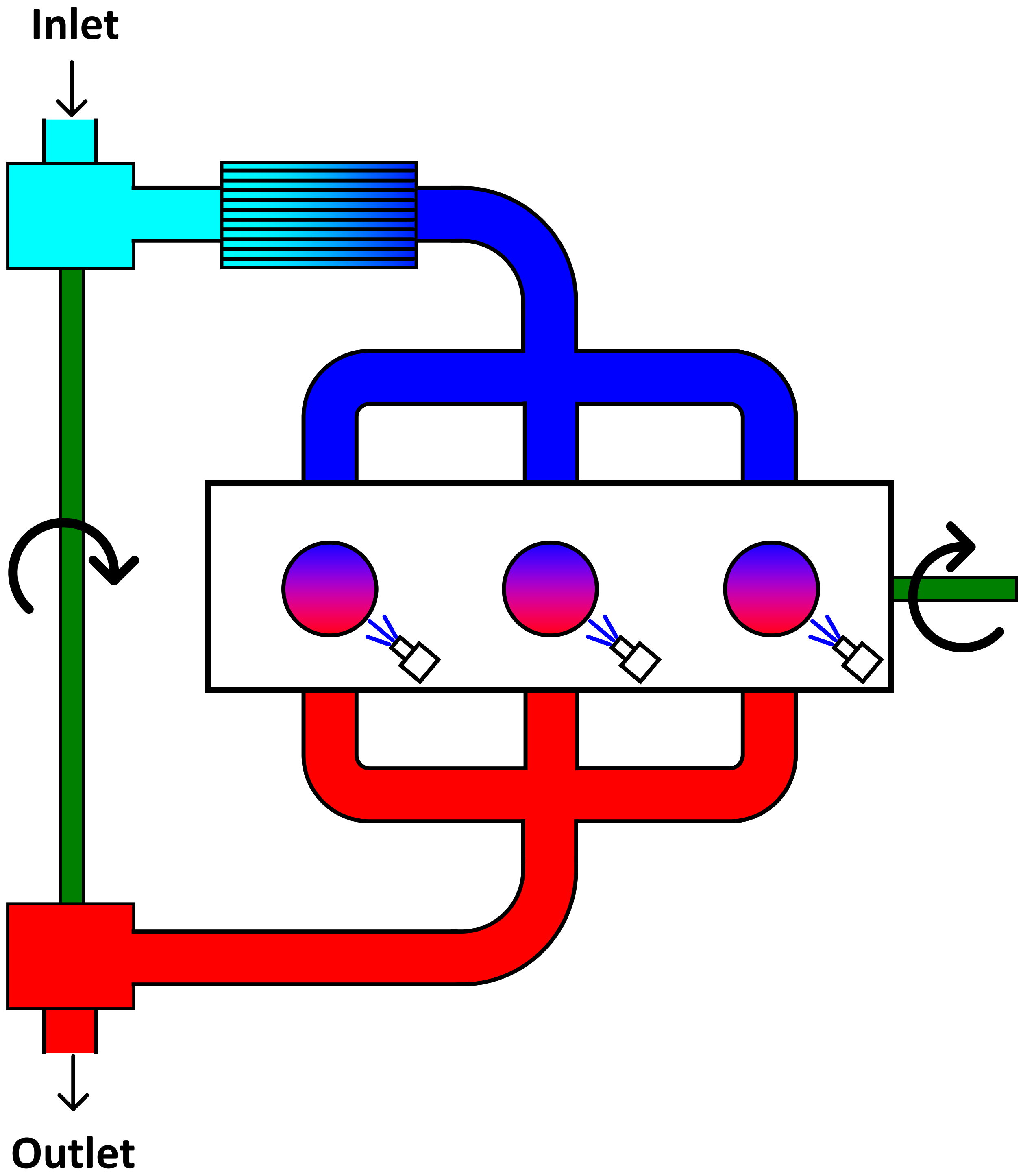

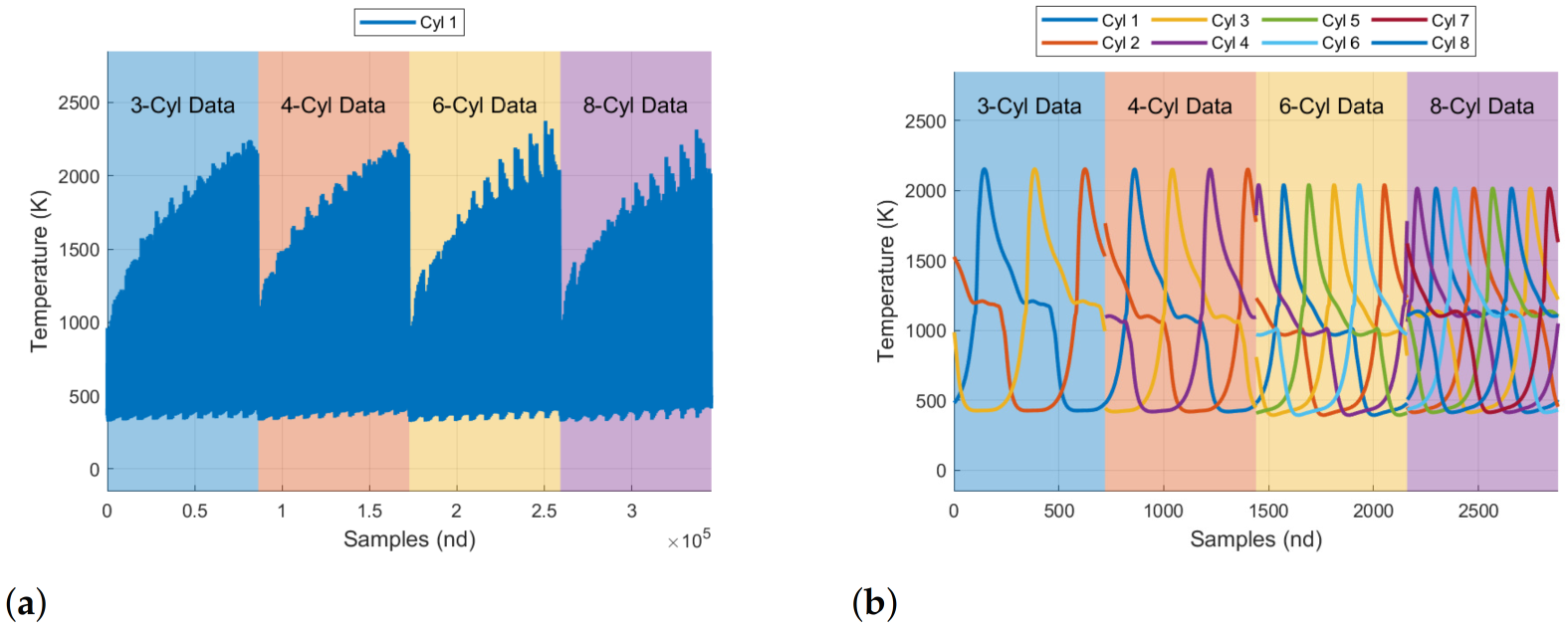

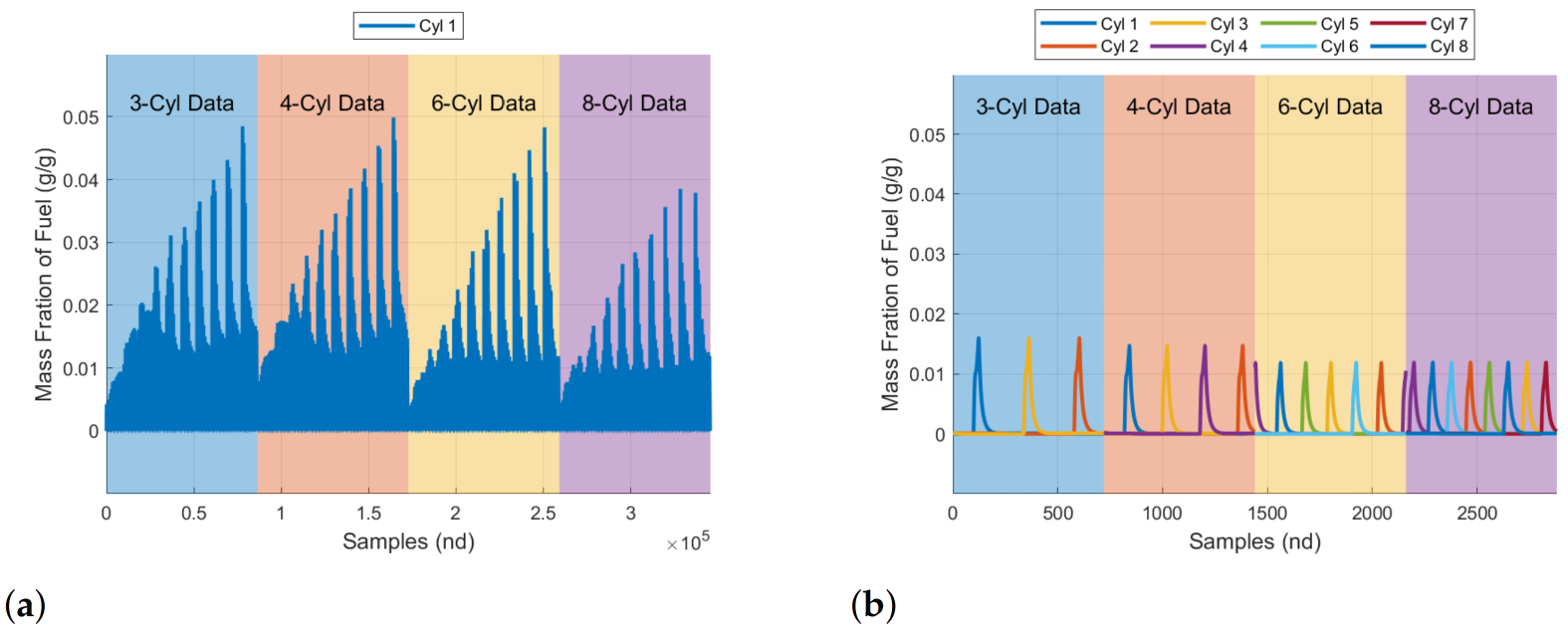
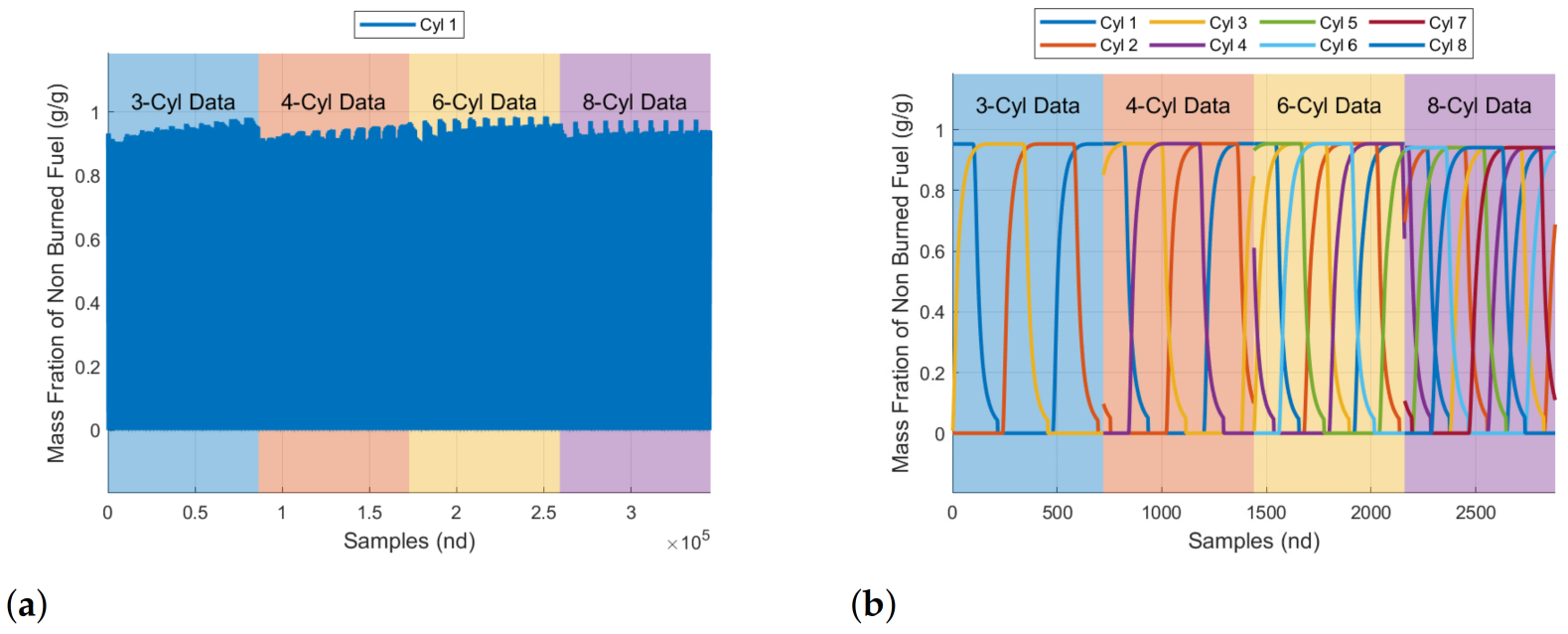

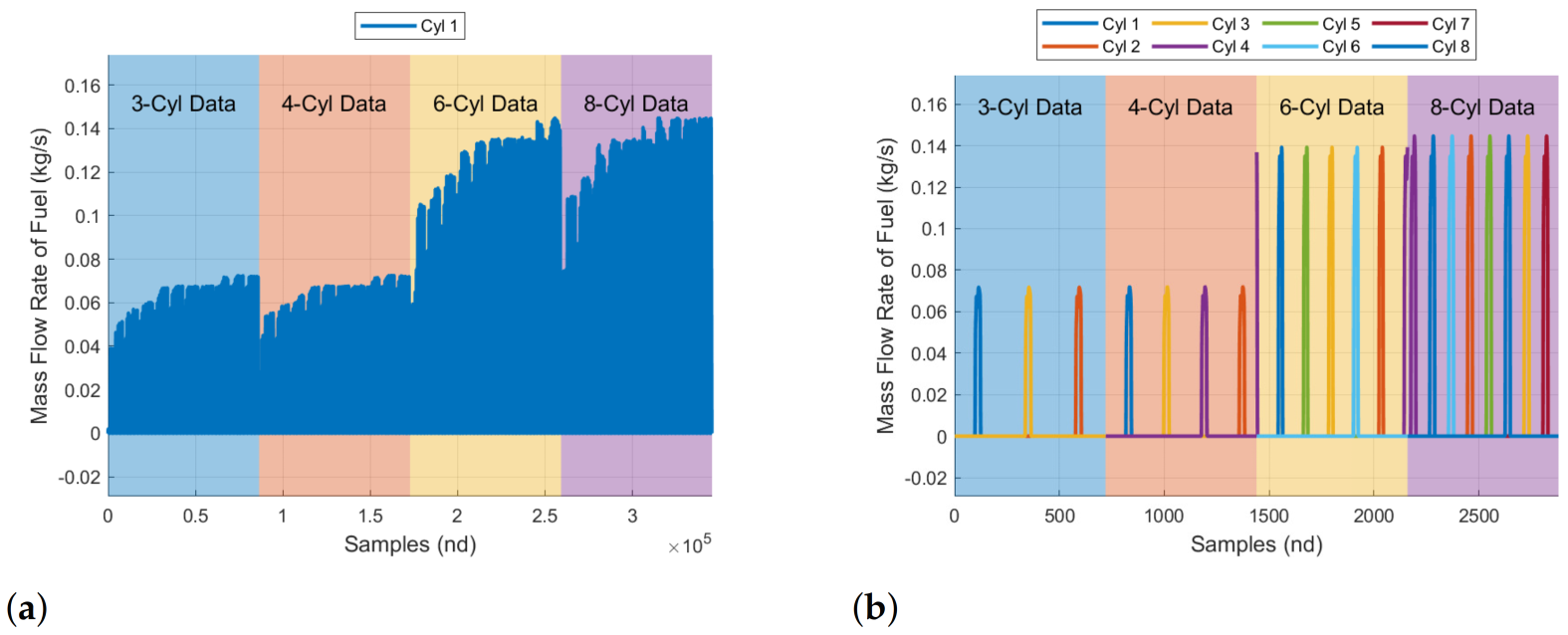

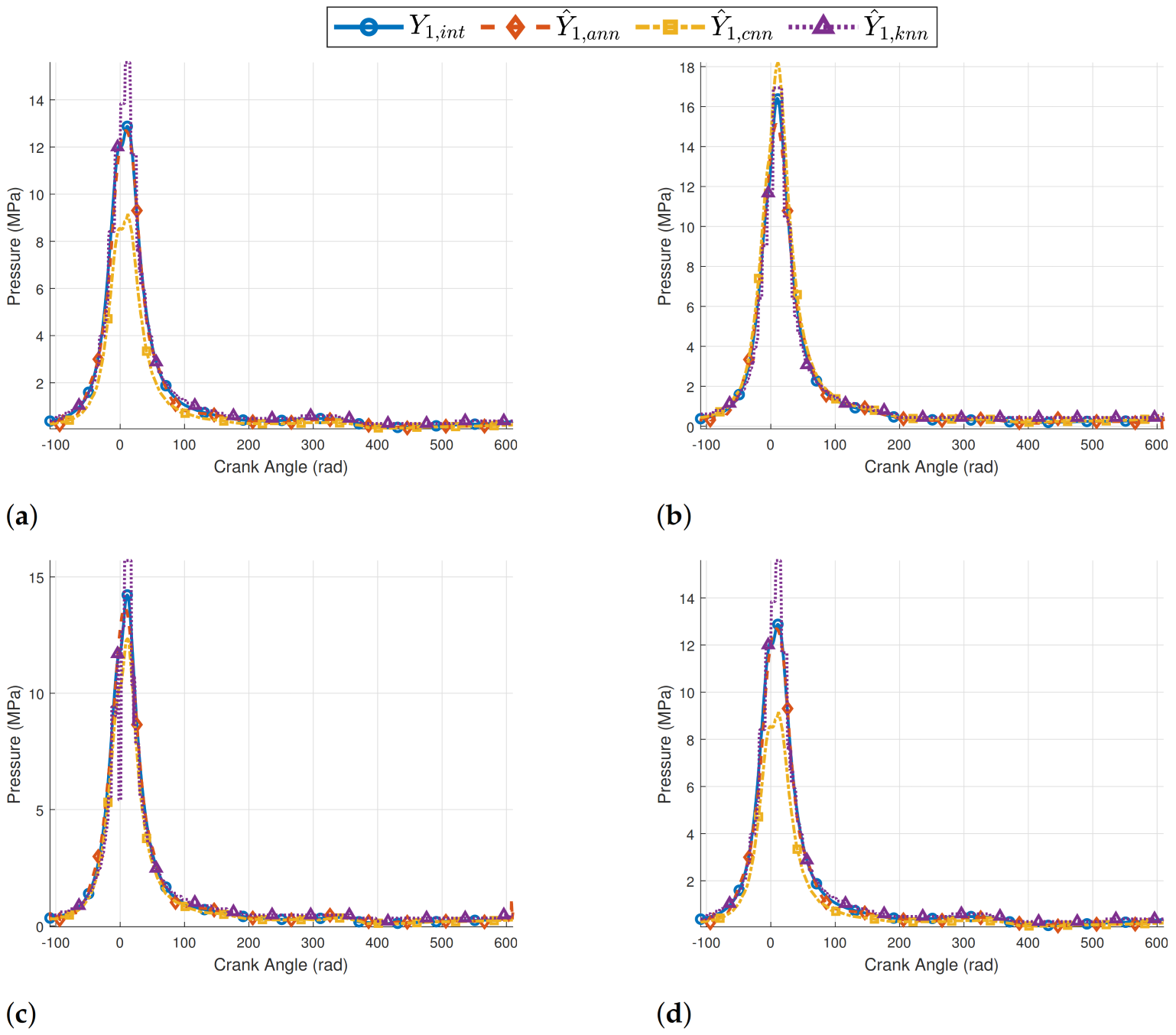
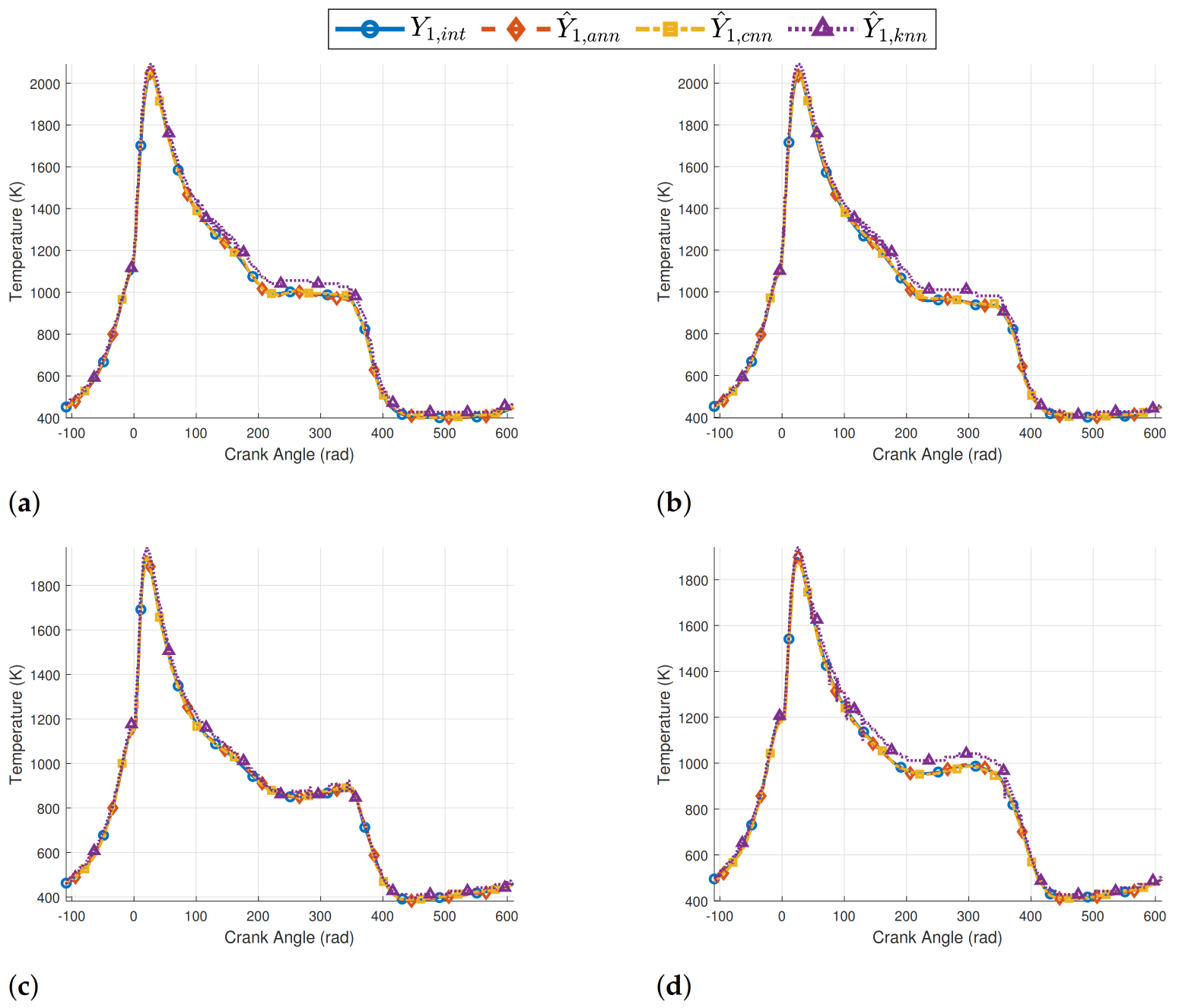
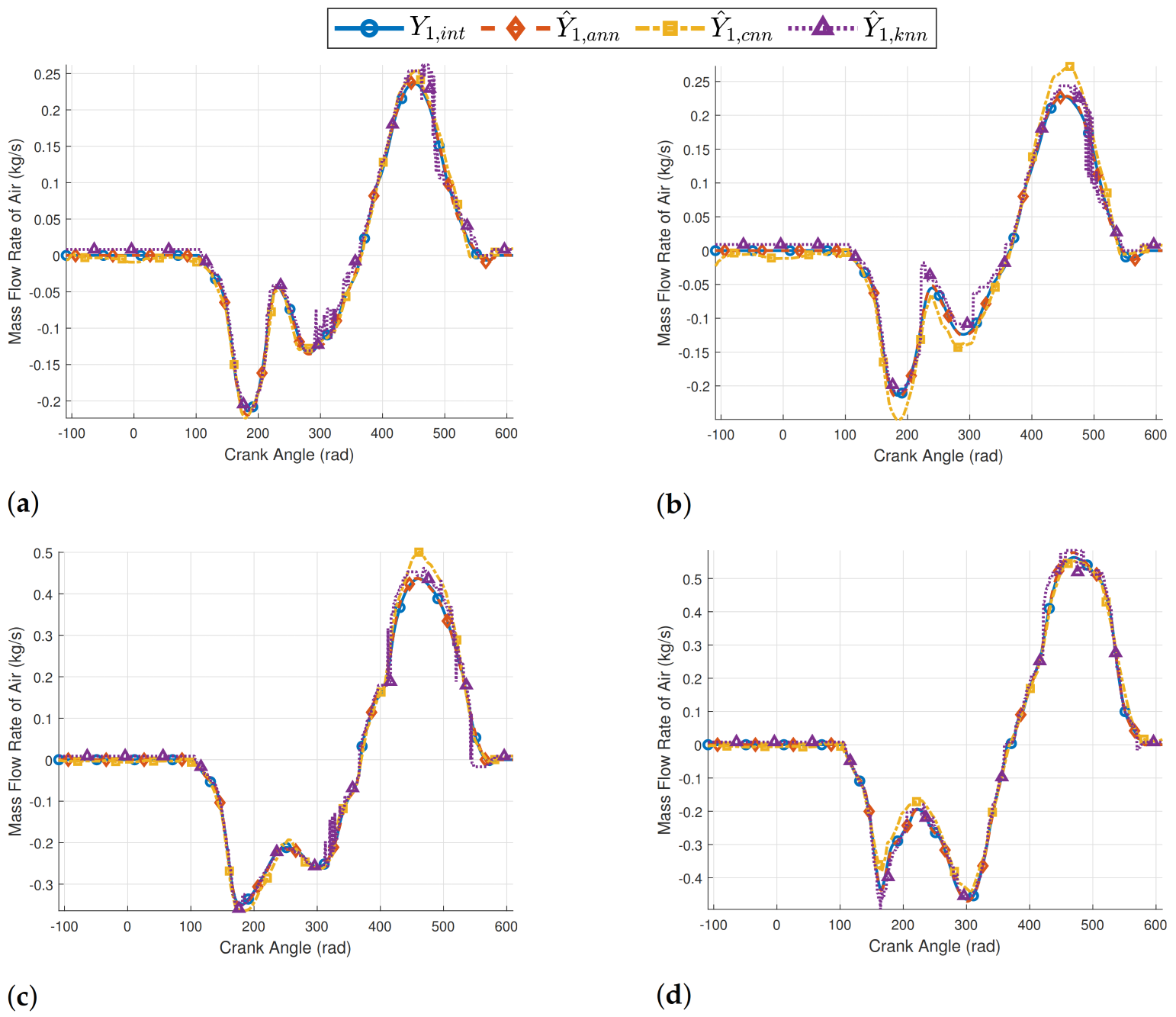
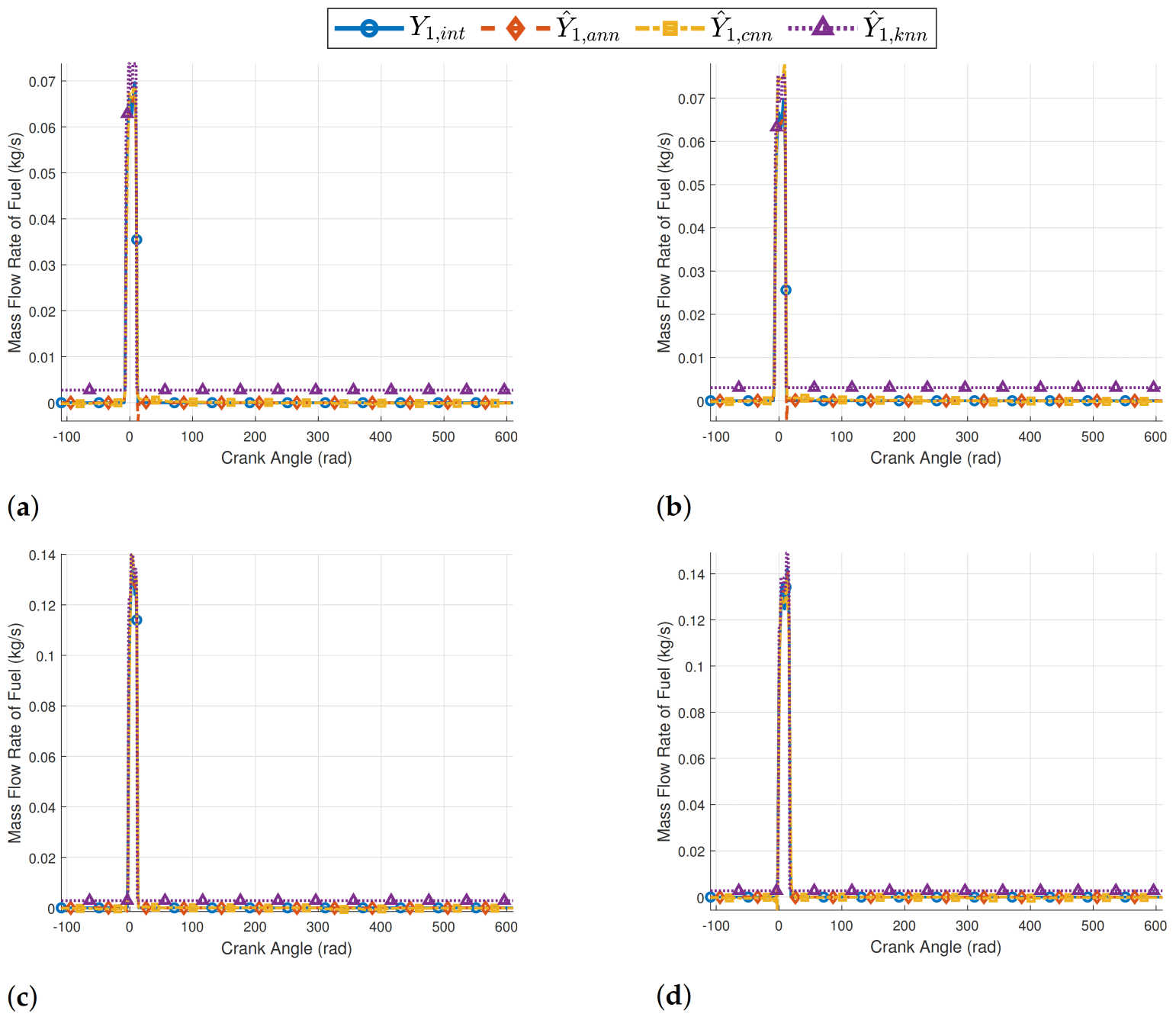
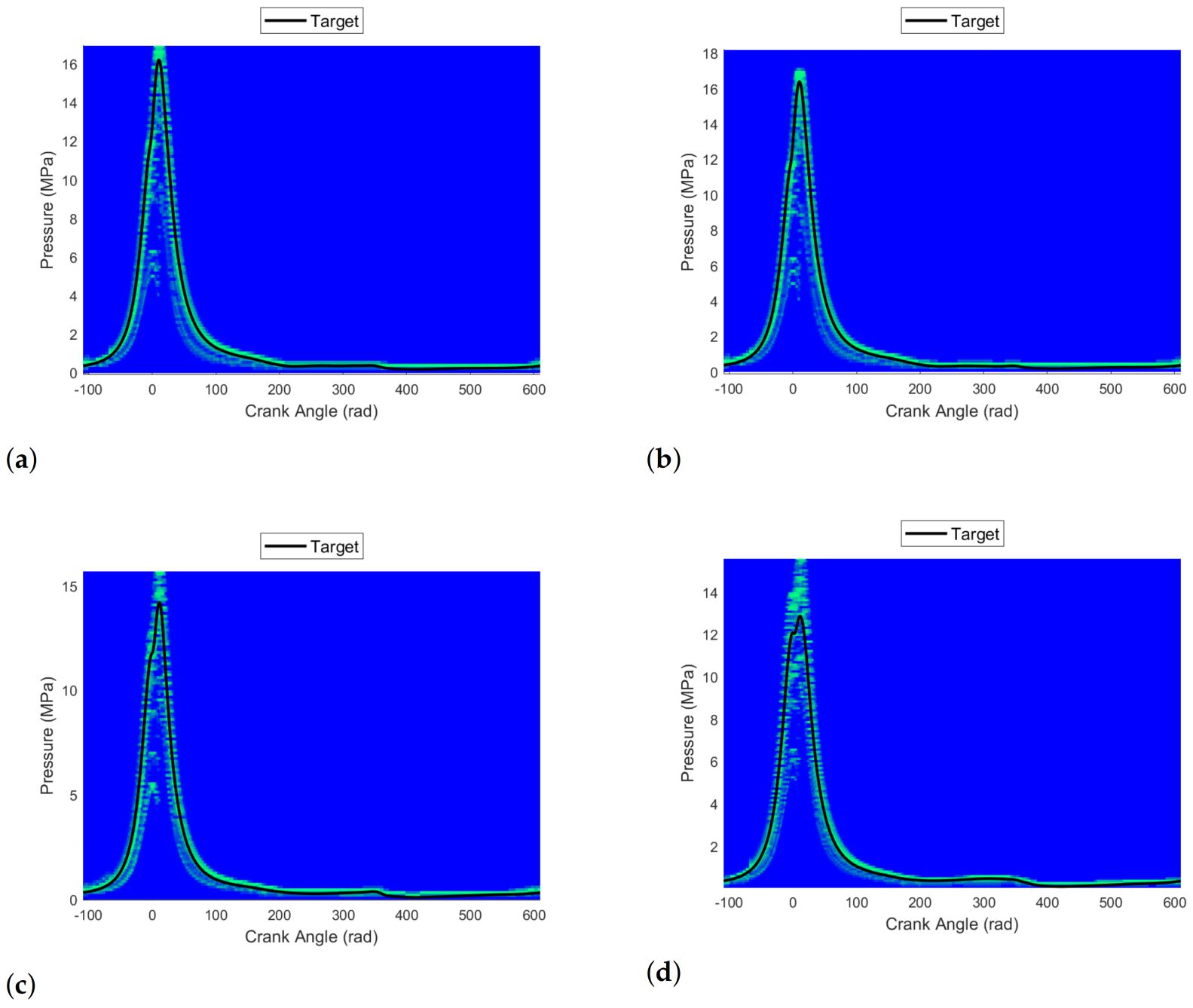
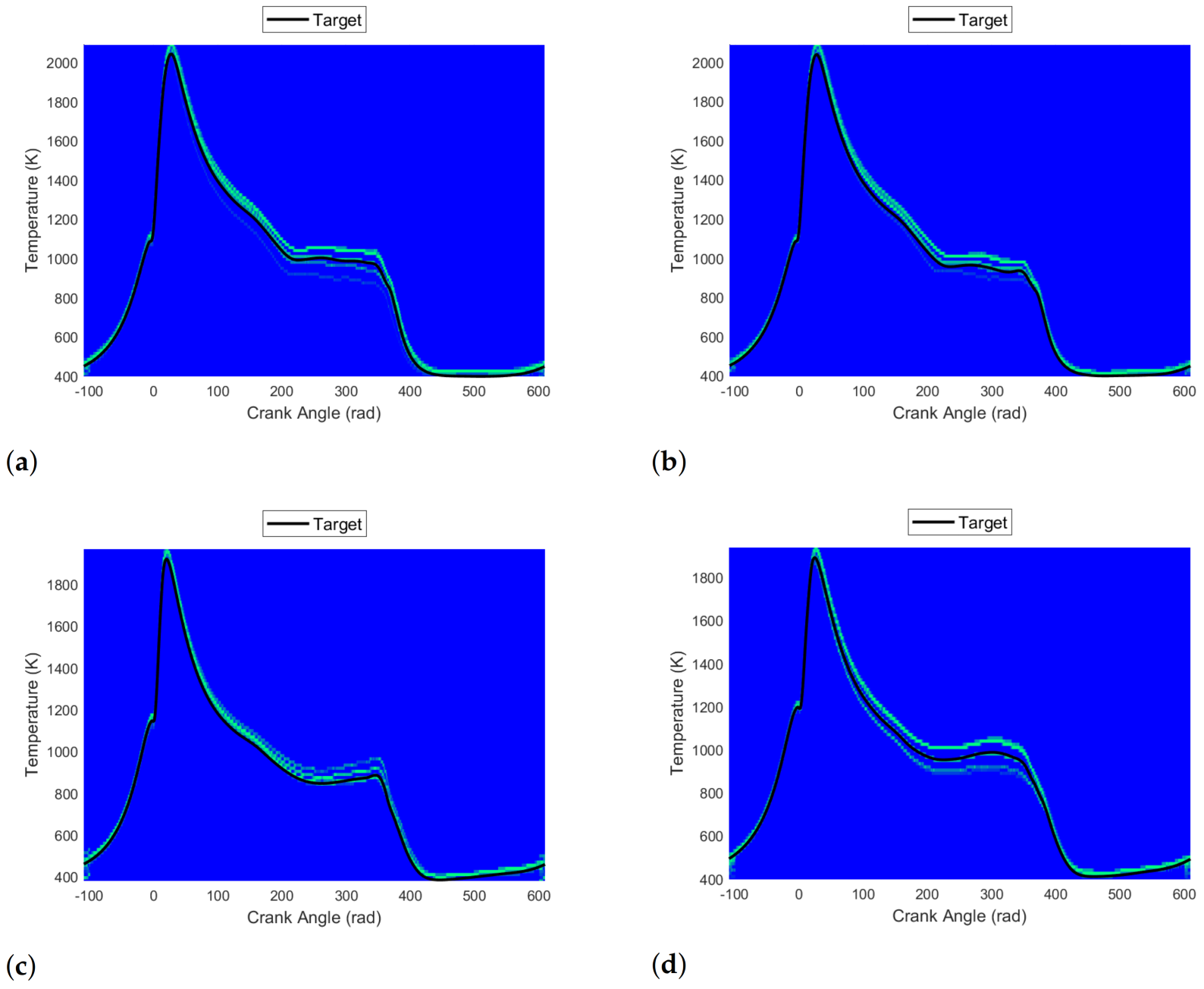

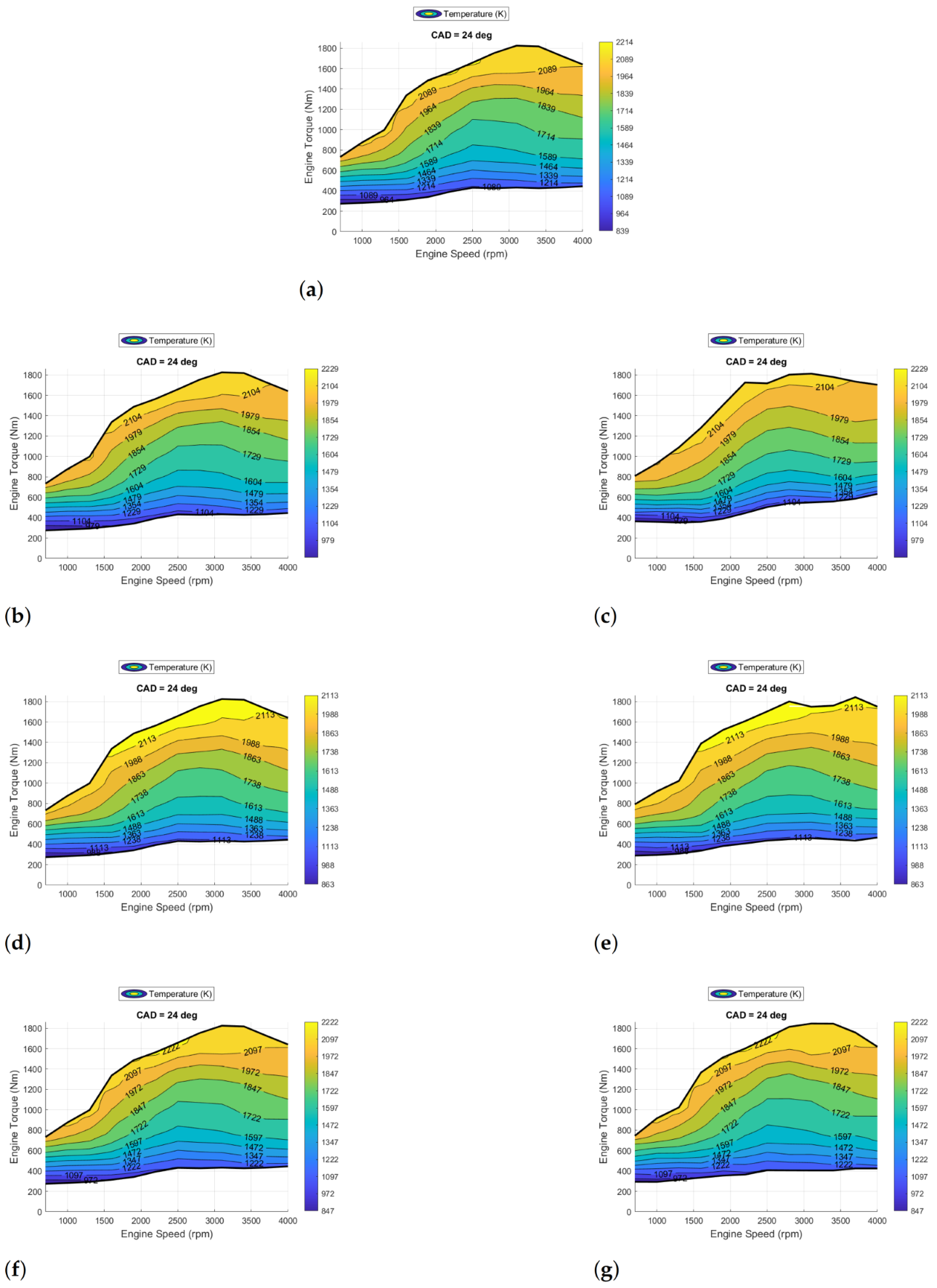
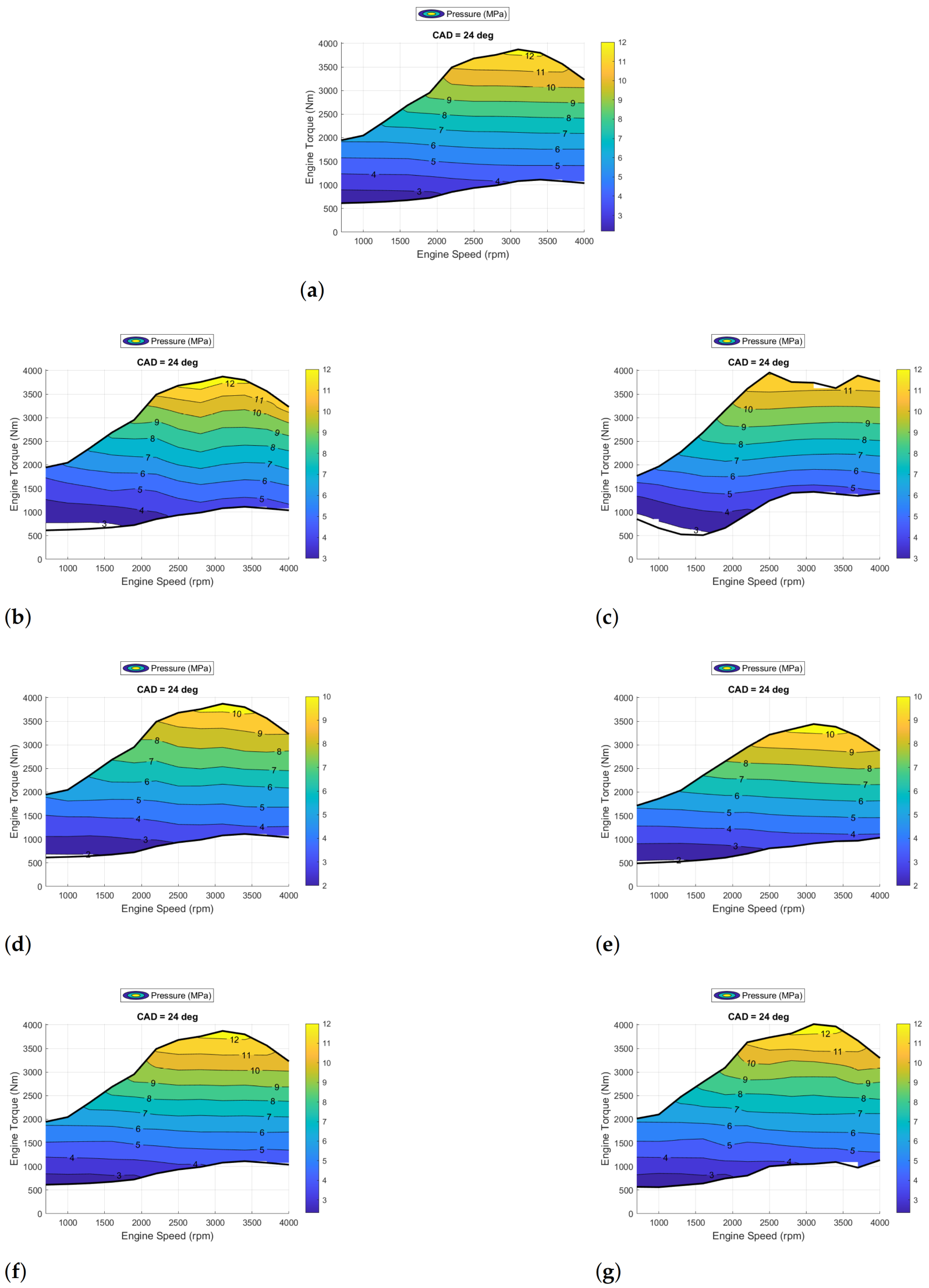

| Mean Squared Error (MSE) | |||
|---|---|---|---|
| Variable | ANN | CNN | KNN |
| P4 | 1.8283 | ||
| 3.2881 | 4.8308 | 1.5617 | |
| 5.6820 | 2.0810 | 4.1623 | |
| 6.2206 | 7.1954 | 1.9456 | |
| 2.8999 | 9.4247 | 1.1196 | |
| 1.0925 | 1.2275 | 1.9477 | |
| 8.1833 | 2.3117 | 5.9120 | |
| 1.9412 | 4.9126 | 1.6713 | |
| Mean Squared Error (MSE) | |||
|---|---|---|---|
| Variable | ANN | CNN | KNN |
| P4 | 4.1816 | 1.7304 | 1.8825 |
| 3.2321 | 7.3844 | 1.4113 | |
| 3.2068 | 1.7228 | 5.2345 | |
| 5.8979 | 3.5265 | 2.6663 | |
| 3.0218 | 2.3667 | 1.1989 | |
| 6.1963 | 5.5871 | 1.1168 | |
| 4.1992 | 2.3577 | 4.6409 | |
| 9.3972 | 3.3866 | 1.5608 | |
| Mean Squared Error (MSE) | |||
|---|---|---|---|
| Variable | ANN | CNN | KNN |
| P4 | 2.9740 | 1.7859 | 4.0121 |
| 2.8046 | 5.7238 | 5.9782 | |
| 3.2783 | 2.8521 | 5.1191 | |
| 8.2437 | 4.3717 | 4.4307 | |
| 5.0835 | 1.8659 | 1.9803 | |
| 7.5972 | 7.1091 | 5.1877 | |
| 2.0736 | 5.3221 | 2.6519 | |
| 1.3971 | 5.1253 | 5.3425 | |
| Mean Squared Error (MSE) | |||
|---|---|---|---|
| Variable | ANN | CNN | KNN |
| 2.4989 | 8.9454 | 1.8696 | |
| P4 | 3.8406 | 6.6977 | 1.4447 |
| 3.8753 | 1.8690 | 4.6453 | |
| 1.7736 | 4.6630 | 4.2817 | |
| 5.5587 | 3.2369 | 1.8104 | |
| 1.3654 | 1.2100 | 1.6471 | |
| 8.1720 | 4.6813 | 1.9948 | |
| 1.2606 | 8.1151 | 1.9376 | |
Publisher’s Note: MDPI stays neutral with regard to jurisdictional claims in published maps and institutional affiliations. |
© 2022 by the authors. Licensee MDPI, Basel, Switzerland. This article is an open access article distributed under the terms and conditions of the Creative Commons Attribution (CC BY) license (https://creativecommons.org/licenses/by/4.0/).
Share and Cite
Jane, R.; Kim, T.Y.; Rose, S.; Glass, E.; Mossman, E.; James, C. Developing AI/ML Based Predictive Capabilities for a Compression Ignition Engine Using Pseudo Dynamometer Data. Energies 2022, 15, 8035. https://doi.org/10.3390/en15218035
Jane R, Kim TY, Rose S, Glass E, Mossman E, James C. Developing AI/ML Based Predictive Capabilities for a Compression Ignition Engine Using Pseudo Dynamometer Data. Energies. 2022; 15(21):8035. https://doi.org/10.3390/en15218035
Chicago/Turabian StyleJane, Robert, Tae Young Kim, Samantha Rose, Emily Glass, Emilee Mossman, and Corey James. 2022. "Developing AI/ML Based Predictive Capabilities for a Compression Ignition Engine Using Pseudo Dynamometer Data" Energies 15, no. 21: 8035. https://doi.org/10.3390/en15218035
APA StyleJane, R., Kim, T. Y., Rose, S., Glass, E., Mossman, E., & James, C. (2022). Developing AI/ML Based Predictive Capabilities for a Compression Ignition Engine Using Pseudo Dynamometer Data. Energies, 15(21), 8035. https://doi.org/10.3390/en15218035






